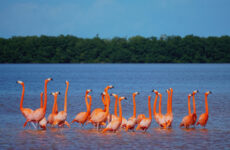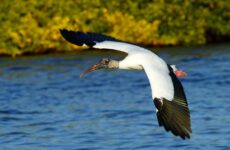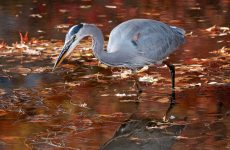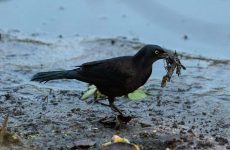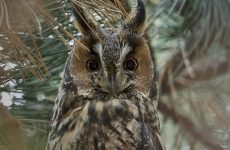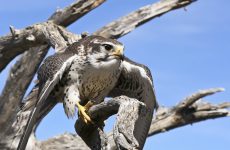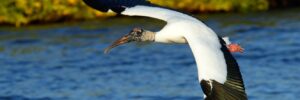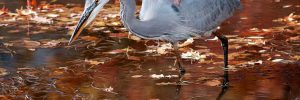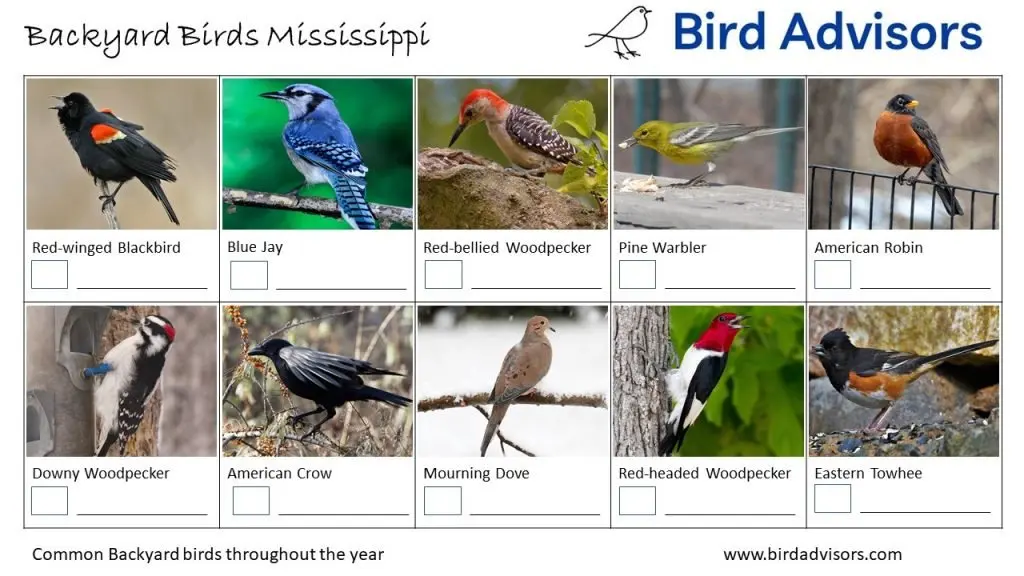
Have you wondered what those birds are that are visiting your backyard in Mississippi?
Well, this guide will help you to find out how to identify these birds by sight and sound and what time of year you can spot them in Mississippi. Also, get a free ID chart to print with the most common backyard birds in Mississippi.
Backyard birds in Mississippi all year: Northern Cardinal, Blue Jay, Northern Mockingbird, Red-bellied Woodpecker, Carolina Wren, Carolina Chickadee, Mourning Dove, Red-winged Blackbird, Eastern Bluebird, Tufted Titmouse, Eastern Towhee, American Crow, Downy Woodpecker, European Starling, House Finch, Pine Warbler, Common Grackle, Brown-headed Cowbird, Red-headed Woodpecker, House Sparrow, Chipping Sparrow
Backyard birds in Mississippi in summer: Barn Swallow, Indigo Bunting, Ruby-throated Hummingbird, Common Yellowthroat
Backyard birds in Mississippi in winter: Yellow-rumped Warbler, White-throated Sparrow, American Robin, Eastern Phoebe, American Goldfinch, Ruby-crowned Kinglet, Northern Flicker
These are the most common backyard birds in Mississippi that may visit your lawn or feeders. They are the birds that appear most frequently on state checklists submitted by bird watchers on ebird.
This article gives you identification information and photos to help you identify and attract more of the common backyard birds that you can spot in Mississippi.
If you like backyard birding you will probably enjoy spotting some ducks in Mississippi too.
Free Printable Backyard Birds ID Charts for Mississippi
These free bird identification worksheets have all the common backyard birds in Mississippi at different times of the year. So when you want to do some backyard birding, these handy guides have pictures and space to either tick off the types of birds you have seen or keep a tally of the total number of birds.

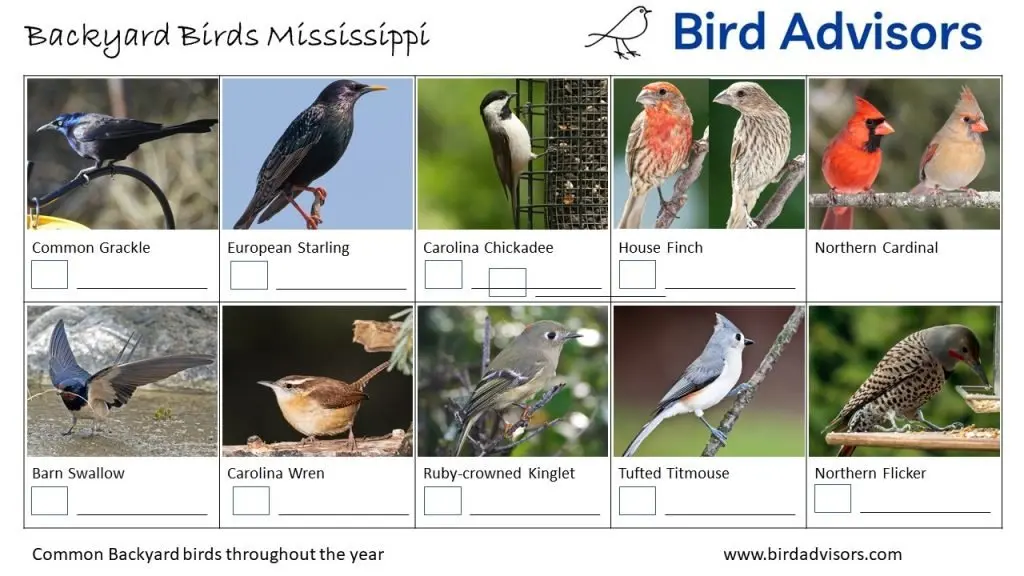
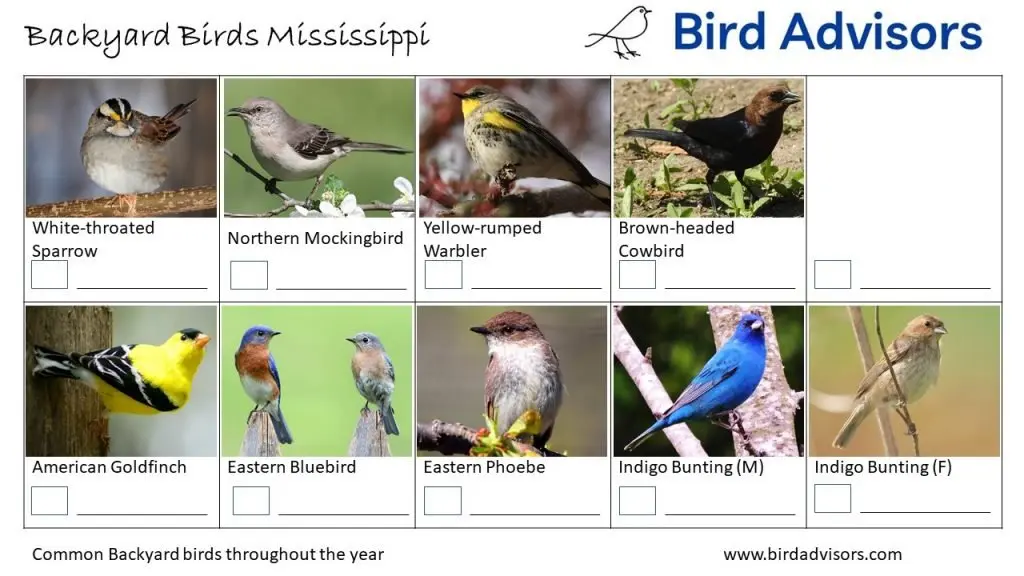
Top 32 Backyard Birds In Mississippi
1. Northern Cardinal
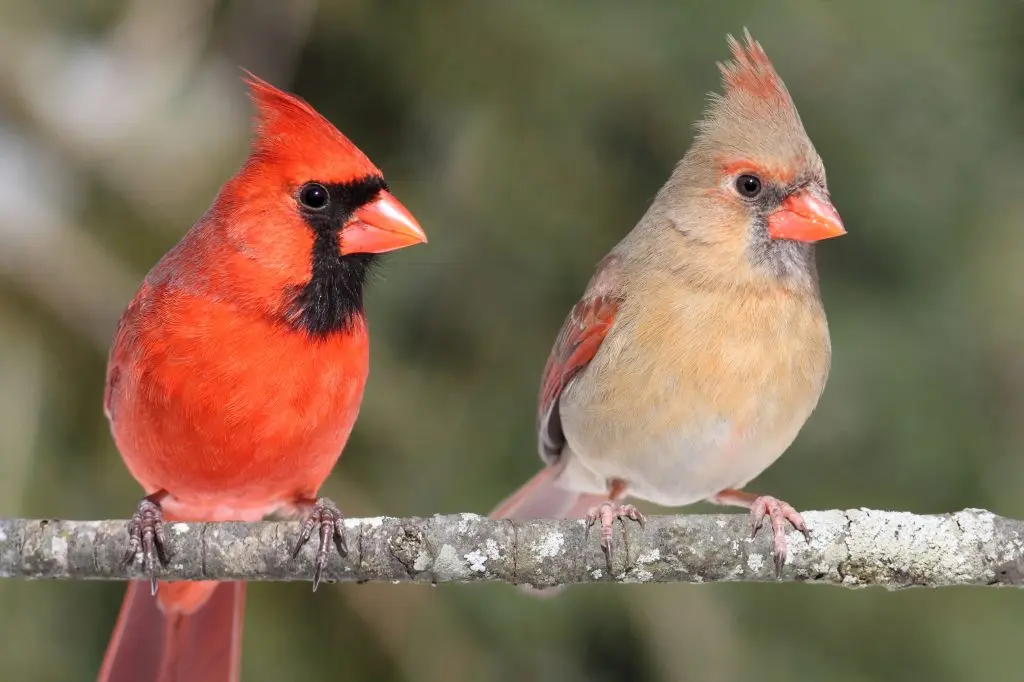
Northern Cardinals are the most frequently spotted birds in Mississippi and are residents of the state all year. They are recorded in 60% of summer checklists and 51% of winter checklists submitted by the bird watchers for the state.
The bright red male Northern Cardinal with black around their faces is an incredible sight, especially against a white winter background. They also have red crests and beaks.
Females are also a little showy with their brown coloring, sharp brown crest, red highlights, and red beaks.
- Cardinalis cardinalis
- Length: 8.3-9.1 in (21-23 cm)
- Weight: 1.5-1.7 oz (42-48 g)
- Wingspan: 9.8-12.2 in (25-31 cm)
Northern Cardinals live in the Eastern half of the US and some states in the south as far west as Arizona.
You can find Northern Cardinals in dense vegetation foraging for seeds, fruit, and insects. Northern Cardinals will sometimes attack their own reflection during the breeding season as they obsessively defend their territories.
Northern Cardinal Song:
Northern Cardinal Call:
Attract Northern Cardinals to your backyard with feeders full of sunflower seeds, peanut hearts, millet, and milo. They will feed from large tube feeders, hoppers, platform feeders, or food scattered on the ground.
There are lots of other red birds in Mississippi that you can spot.
2. Blue Jay
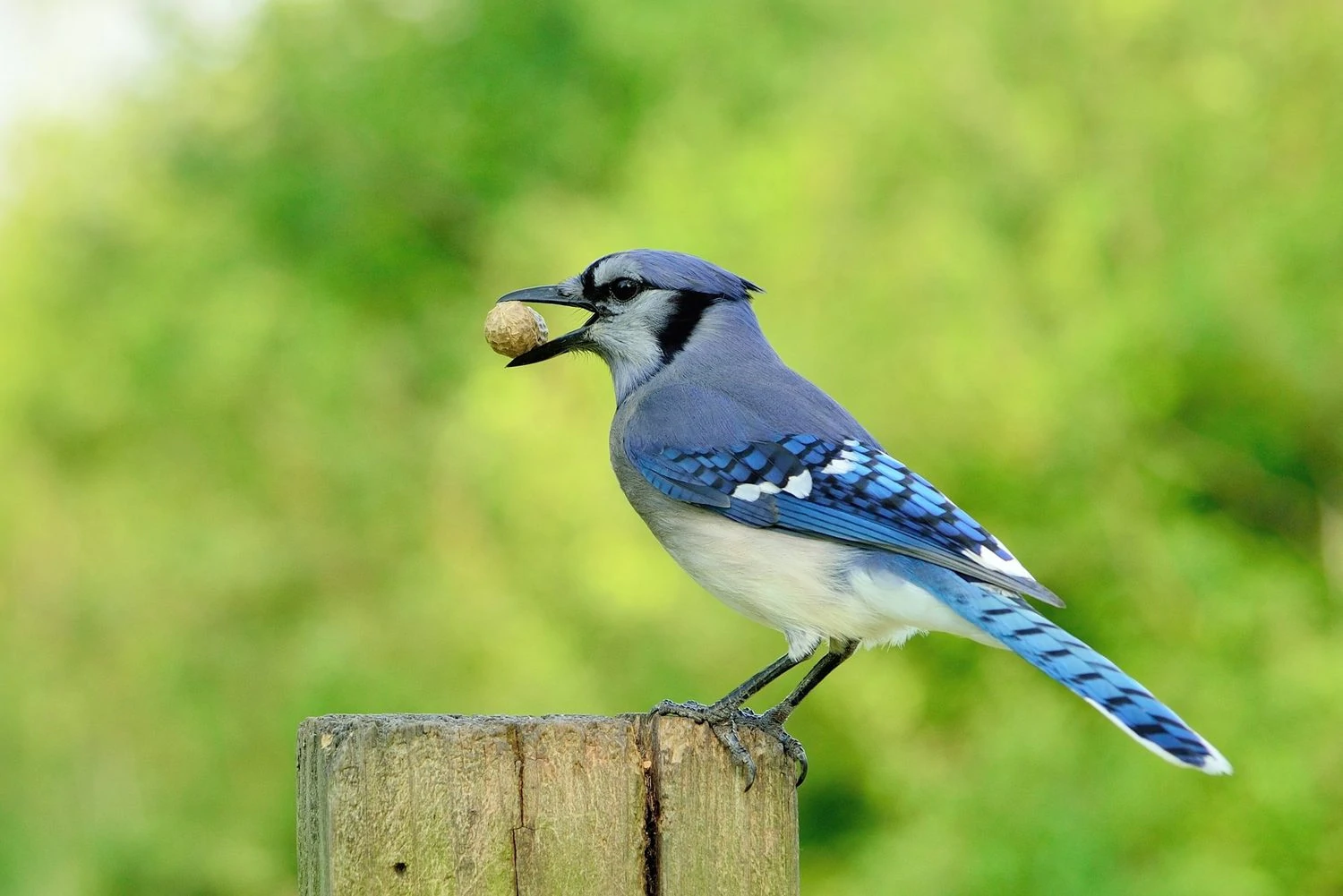
Blue Jays live in Mississippi all year round. They are spotted in 49% of summer checklists and 41% of winter checklists for the state.
Blue Jays are common large songbirds with a blue upright crest, blue and black backs, and white undersides.
- Cyanocitta cristata
- Length: 9.8-11.8 in (25-30 cm)
- Weight: 2.5-3.5 oz (70-100 g)
- Wingspan: 13.4-16.9 in (34-43 cm)
Blue Jays live in eastern US states and Southern Canada all year. Some birds will migrate west for winter but not very frequently.
They are noisy birds that travel in family groups eating acorns when available. They can be found in forests, mainly near oak, as they eat acorns. They can also be found in backyards near feeders. As well as acorns, they eat insects, nuts and seeds, and grain. They may also take eggs from nests or take nestlings.
Blue Jay Call:
Blue Jays are large birds and prefer to fly in, grab a peanut or sunflower seed and take it away to feed. They prefer platform or tray feeders to make it easy to make a quick exit.
Attract Blue Jays to your backyard with peanuts, sunflower seeds, and suet. They prefer these on open tray feeders or hopper feeders on a post. They will also enjoy a birdbath.
3. Yellow-rumped Warbler
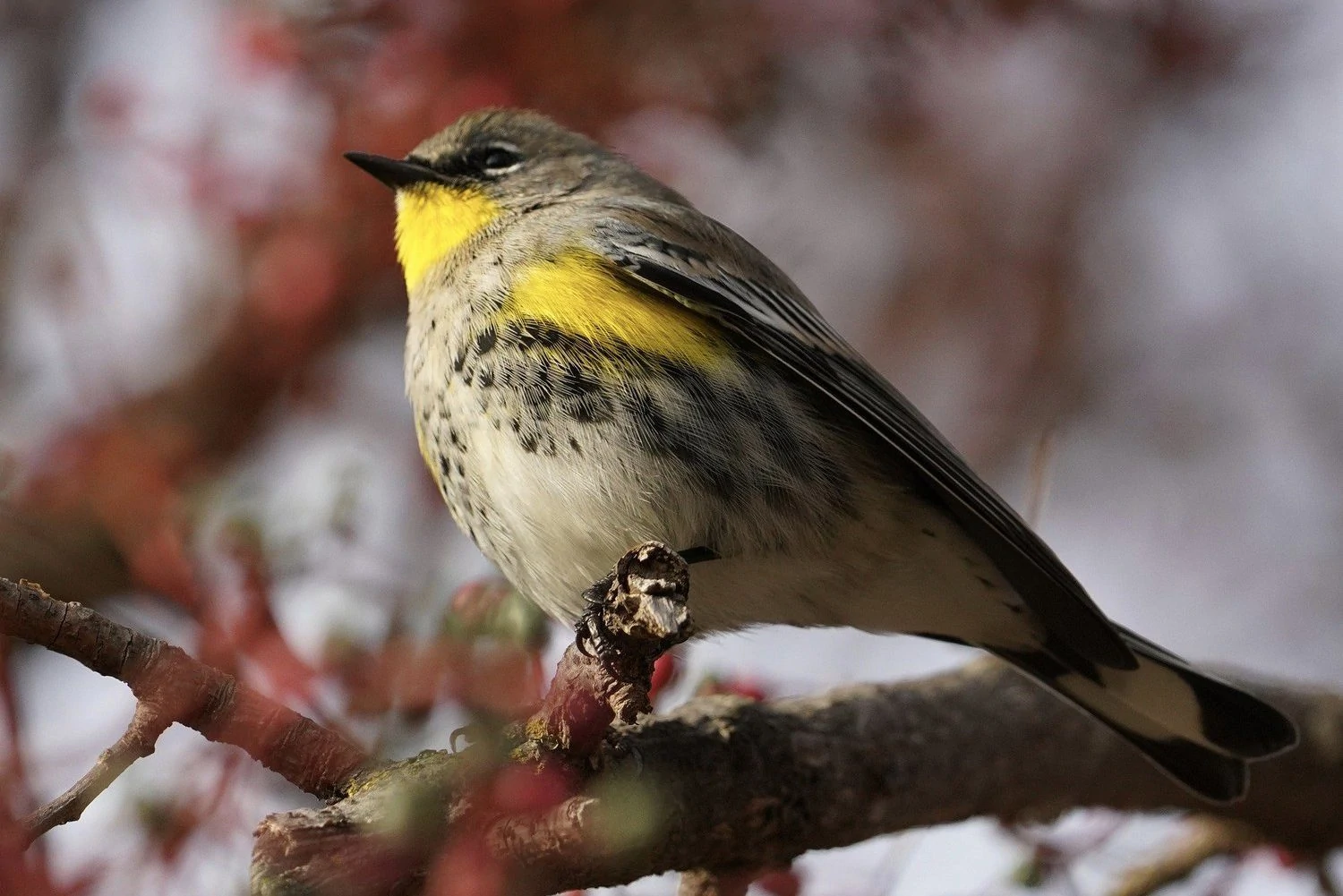
Yellow-rumped Warblers are winter birds in Mississippi that start arriving in September, and some stay until May, but October until April are the best months to spot them. They are recorded in 36% of winter checklists submitted by the bird watchers for the state.
Yellow-rumped Warblers are gray with flashes of yellow on the face, sides, and rump and white in the wings.
Females may be slightly brown, and winter birds are paler brown with bright yellow rumps and sides turning bright yellow and gray again in spring.
- Setophaga coronata
- Length: 4.7-5.5 in (12-14 cm)
- Weight: 0.4-0.5 oz (12-13 g)
- Wingspan: 7.5-9.1 in (19-23 cm)
Yellow-rumped Warblers breed predominantly in Canada and parts of the Rockies and the Appalachian mountains.
During migration, they can be seen in the Midwest before overwintering in southern and southwestern US states and the Pacific Coast, and into Mexico and Central America.
You can find Yellow-rumped Warblers in coniferous forests, especially during the breeding season. During winter, they can be found in open areas with fruiting shrubs. In summer, they eat mostly insects and on migration, and in winter, they eat mostly fruit, including bayberry and wax myrtle.
Yellow-rumped Warbler Song:
Attract Yellow-rumped Warblers to your backyard with sunflower seeds, suet, raisins, and peanut butter.
These colorful and melodious migratory birds don’t stick around for long so be sure to check out all the warblers in Mississippi you can spot before it’s too late.
4. Northern Mockingbird
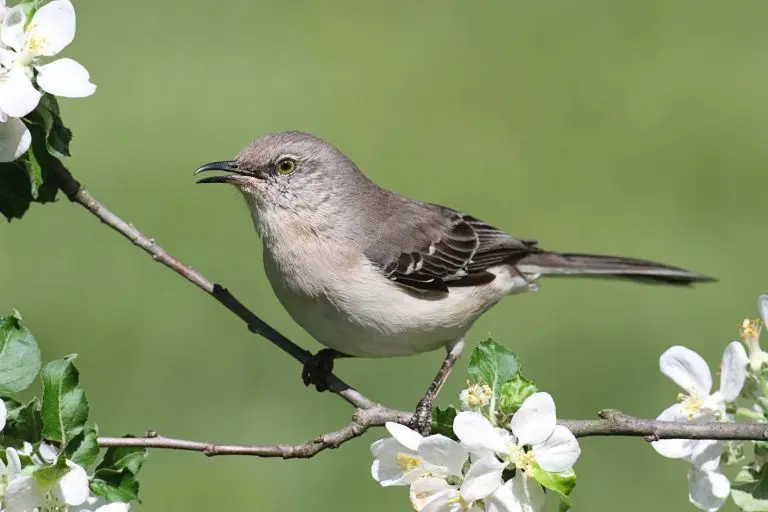
Northern Mockingbirds can be found in Mississippi all year. They are recorded in 50% of summer checklists and 36% of winter checklists for the state.
Northern Mockingbirds are medium-sized songbirds with small heads and long tails. They are a gray-brown color and slightly paler on the underside than their back, and they have two white wingbars visible in flight.
- Mimus polyglottos
- Length: 8.3-10.2 in (21-26 cm)
- Weight: 1.6-2.0 oz (45-58 g)
- Wingspan: 12.2-13.8 in (31-35 cm)
Northern Mockingbirds do not migrate and can be spotted across the lower 48 and southern Canada.
They are usually seen alone or in pairs and aggressively defend their territory. A male mockingbird can learn around 200 songs in its life, copying other birds’ songs, and they can sing all through the day and into the night.
Northern Mockingbird Call/Song:
Attract more Northern Mockingbirds to your backyard by planting fruiting trees or bushes, including hawthorns, mulberries, and blackberry brambles. They don’t often visit feeders, but they will come to open lawn areas.
5. Red-bellied Woodpecker
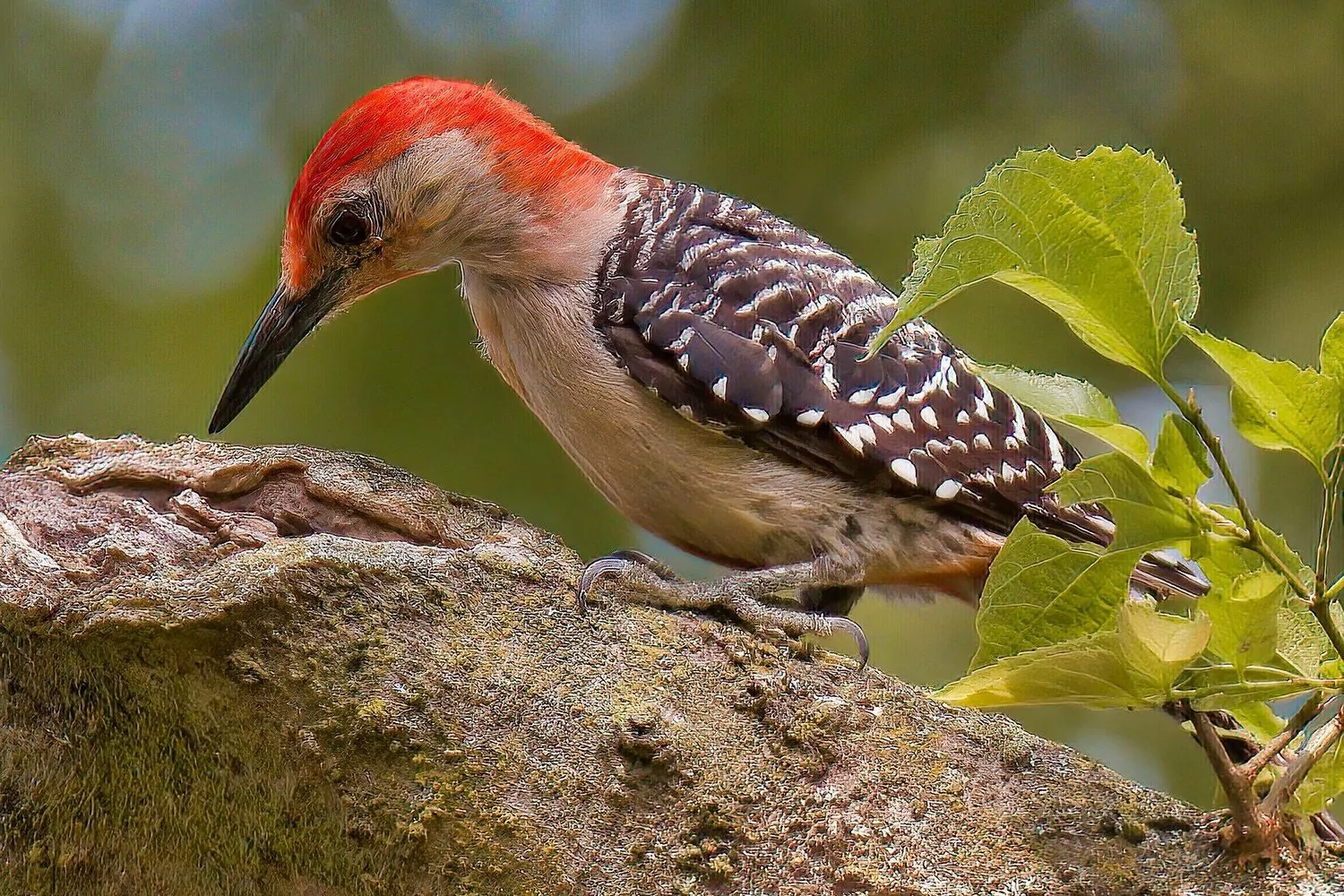
Red-bellied Woodpeckers are common in Mississippi all year and are recorded in up to 36% of summer and winter checklists.
Red-bellied Woodpeckers can be mistaken for Red-headed Woodpeckers as they have red caps, but they are much smaller than the Red-headed Woodpecker. Female Red-bellied Woodpeckers lack the red cap and only have red at the back of their heads.
They also have a very pale red belly that can be hard to spot, but they do have the typical woodpecker black and white markings over their backs.
- Melanerpes carolinus
- Length: 9.4 in (24 cm)
- Weight: 2.0-3.2 oz (56-91 g)
- Wingspan: 13.0-16.5 in (33-42 cm)
Red-bellied Woodpeckers can be found in eastern US states, and they do not migrate.
Red-bellied Woodpeckers eat insects, spiders, seeds from grasses, fruit, and nuts. They will also sometimes eat nestlings. They nest in dead trees and may use the same nest year after year. They lay 4-5 white eggs on a bed of wood chips.
The tongue of the Red-bellied Woodpecker sticks out 2 inches past the beak and is barbed at the tip, along with sticky spit. This helps catch prey from deep crevices.
Red-bellied Woodpecker Call:
Red-bellied Woodpeckers can often be seen at bird feeders, especially if you live near wooded areas. They make a distinctive loud rolling call which means you will often hear them before you see them.
Some woodpeckers are more easily recognized than others, but with this guide, you can identify all the woodpeckers in Mississippi.
6. Carolina Wren
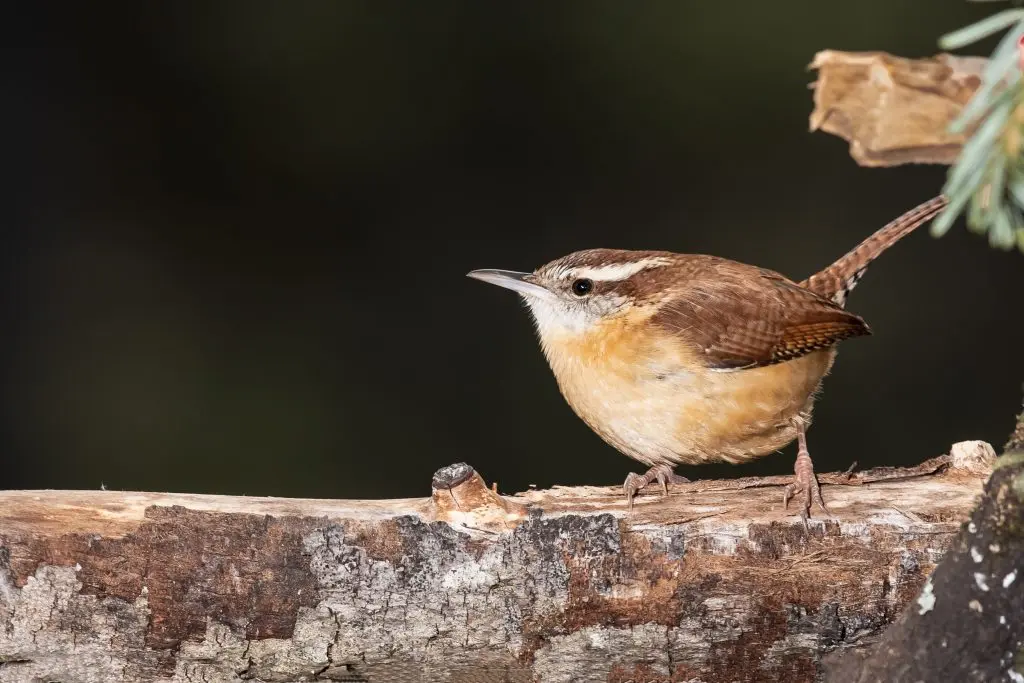
Carolina Wrens do not migrate and are frequently spotted in Mississippi. They appear in 42% of summer checklists and 34% of winter checklists submitted by bird watchers for the state.
Carolina Wrens are shy birds that are dark brown on top and light brown underneath. They have a white eyebrow stripe and upright tail, and a loud ‘teakettle‘ song.
- Thryothorus ludovicianus
- Length: 4.7-5.5 in (12-14 cm)
- Weight: 0.6-0.8 oz (18-22 g)
- Wingspan: 11.4 in (29 cm)
Carolina Wrens are residents all year across eastern and southeastern US States.
You can find them in woods or thickly vegetated areas, and they will visit backyard feeders.
Carolina Wren Song:
Attract Carolina Wrens to your backyard feeders with suet feeders, hulled sunflower seeds, or peanut hearts in large tube feeders or on platform feeders.
Wrens are often overlooked for more flash birds, but take the time to get to know the sight and sounds of wrens in Mississippi.
7. Carolina Chickadee
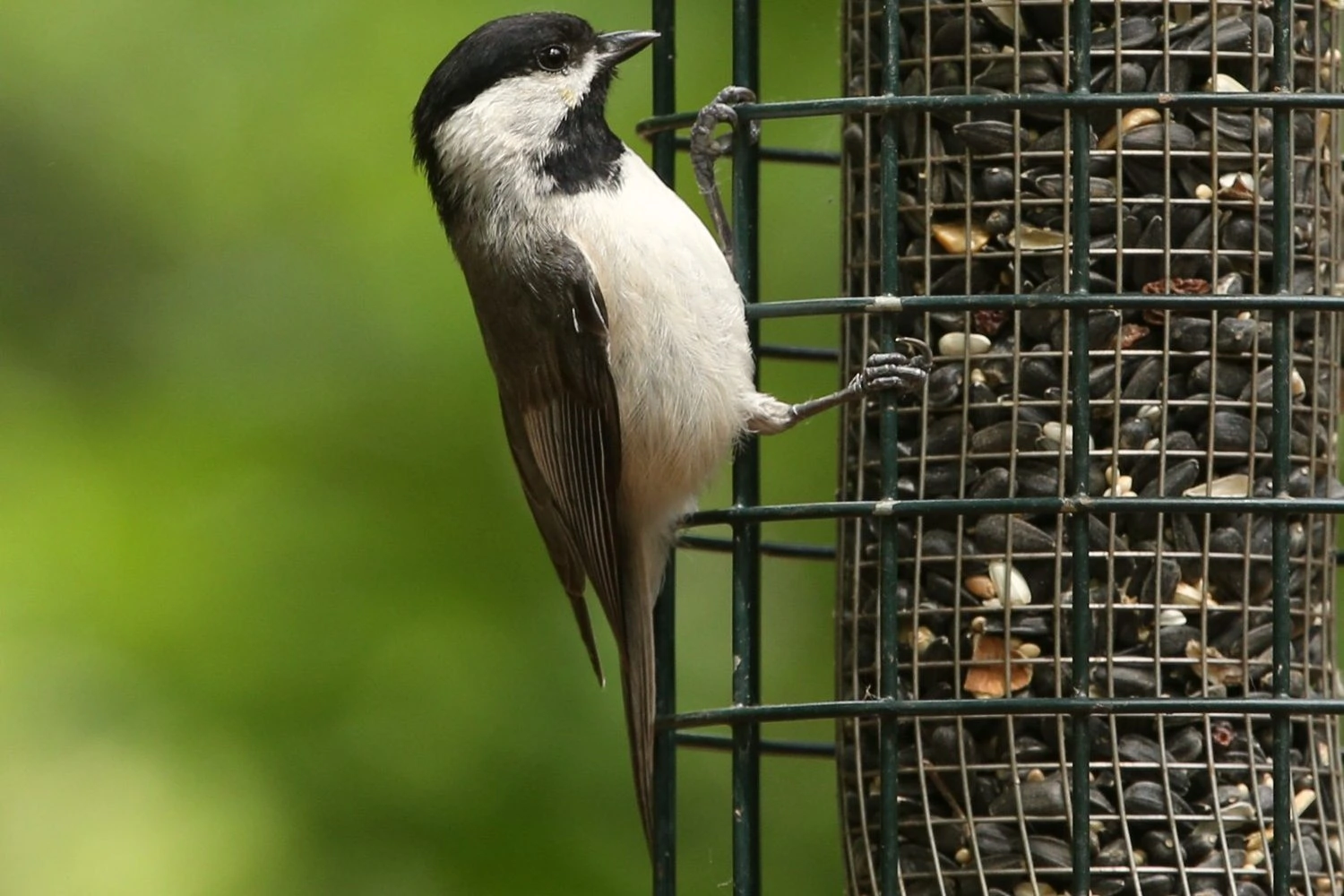
Carolina Chickadees do not migrate and are residents of Mississippi all year. They are very common here and are recorded in 29% of summer checklists and 33% of winter checklists submitted by bird watchers for the state.
Carolina Chickadees are tiny birds with large heads, black caps and necks, white cheeks and bellies, and soft gray backs, wings, and tails.
They are visually very similar to the Black-capped Chickadee, and they interbreed where their range overlaps.
- Poecile carolinensis
- Length: 3.9-4.7 in (10-12 cm)
- Weight: 0.3-0.4 oz (8-12 g)
- Wingspan: 5.9-7.9 in (15-20 cm)
Carolina Chickadees can be found in forested areas, parks, and backyards in eastern and southeastern US states all year.
Carolina Chickadee Song:
Attract Carolina Chickadees to your backyard feeders with black oil sunflower seeds, nyjer seeds, suet feeders, or peanuts. They will feed on most types of feeders, including tube feeders, suet cages, or platform feeders. They will also nest in nest boxes or nest tubes.
You should find out all about the other sociable and inquisitive chickadees in Mississippi.
8. Mourning Dove
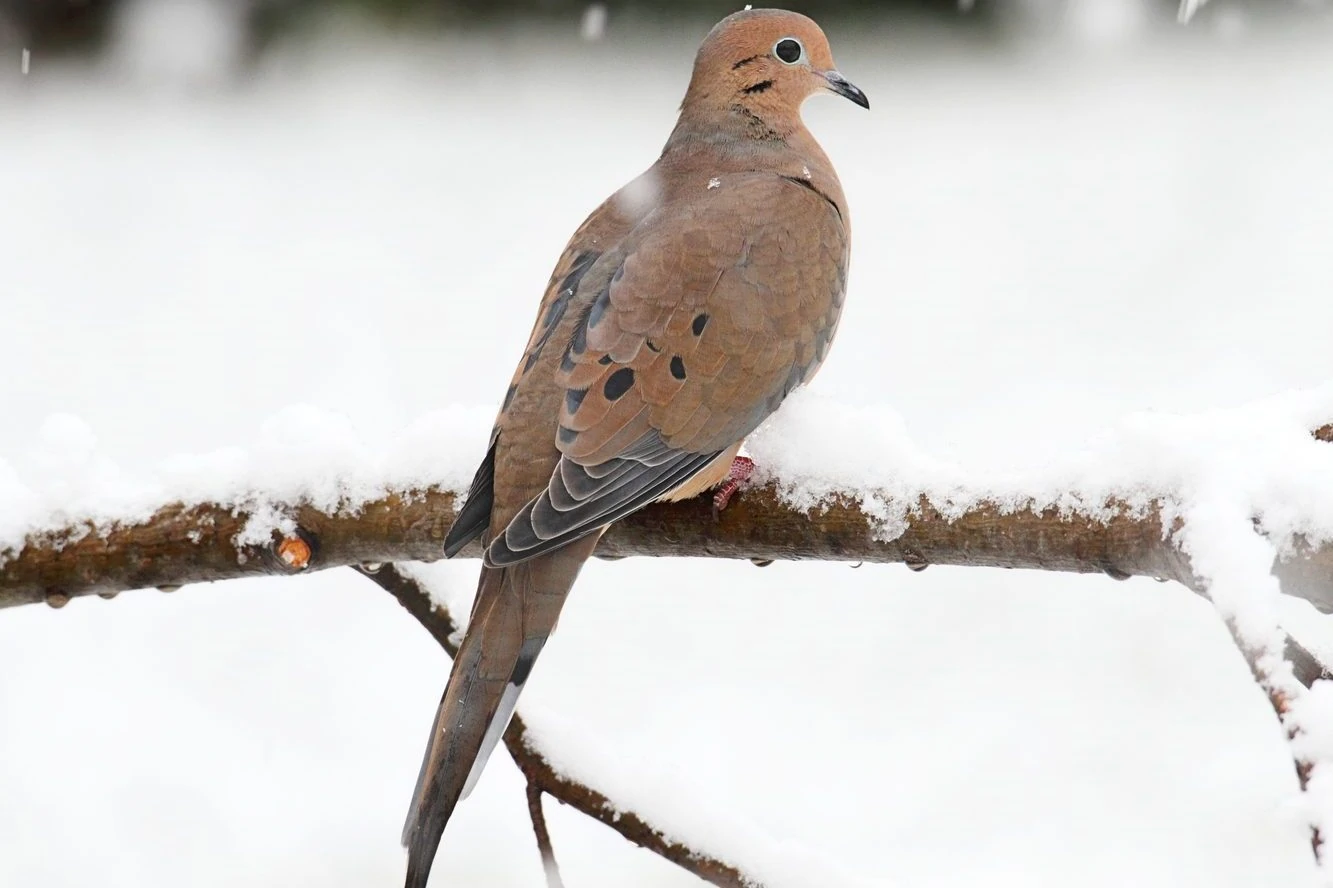
Mourning Doves are very common and can be spotted all year in Mississippi. They occur in 48% of summer checklists and 33% of winter checklists for the state.
Mourning Doves are graceful small-headed birds with plump bodies and long tails. They are a soft brown color with black spots on the wings. Males are slightly heavier than females.
- Zenaida macroura
- Length: 9.1-13.4 in (23-34 cm)
- Weight: 3.0 -6.0 oz (96-170 g)
- Wingspan: 17.7 in (45 cm)
Mourning Doves are common over all of the lower 48 all year but may migrate after breeding from the north of the Midwest and southern Canada.
Mourning Doves can be seen perching on telephone wires and foraging for seeds on the ground in grasslands, fields, and backyards. They can also be found in open areas or woodland edges.
Mourning Dove call:
Attract Mourning Doves to your backyard by scattering millet on the ground or platform feeders. They will also eat black sunflower seeds, nyjer, cracked corn, and peanut hearts.
9. Red-winged Blackbird
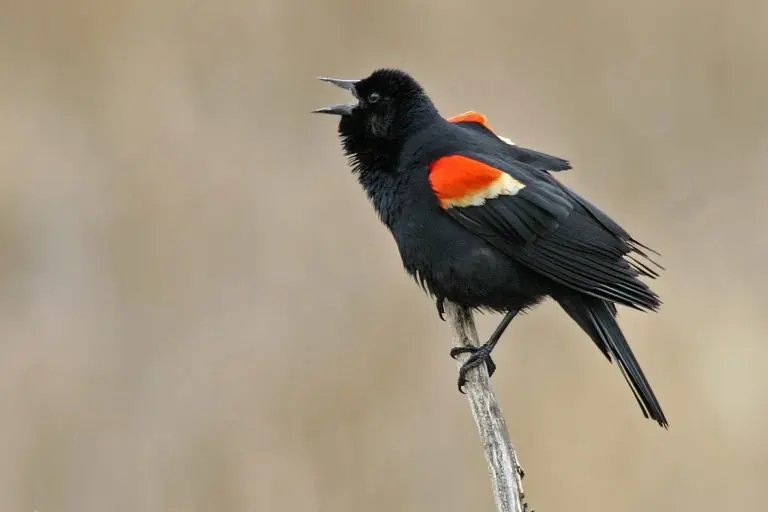
Red-winged blackbirds are very common and can be spotted in Mississippi all year. They appear in 34% of checklists in summer and 26% of checklists in winter submitted by bird watchers for the state.
Red-winged blackbirds are very common and easy to identify with the all-black coloring except for the reddish-orange wing patches. Females are rather dull in comparison with streaky brown color.
- Agelaius phoeniceus
- Length: 6.7-9.1 in (17-23 cm)
- Weight: 1.1-2.7 oz (32-77 g)
- Wingspan: 12.2-15.8 in (31-40 cm)
Red-winged Blackbirds remain all year in the lower 48 and the Pacific Coast of British Columbia. Those that breed in Canada and some northern US states migrate south for the winter.
They can often be spotted sitting on telephone wires, and the males will fiercely defend their territories in the breeding season, even attacking people that get too close to their nests. In winter, they roost in large numbers into the millions.
Red-winged Blackbird Song:
Red-winged Blackbird Calls:
Attract Red-winged blackbirds to your backyard with mixed grain and seeds spread on the ground. They will also feed from large tube feeders or platform feeders.
Blackbirds are a vast family of birds that have numerous family members, and why don’t you get to know all the blackbirds in Mississippi?
10. Eastern Bluebird
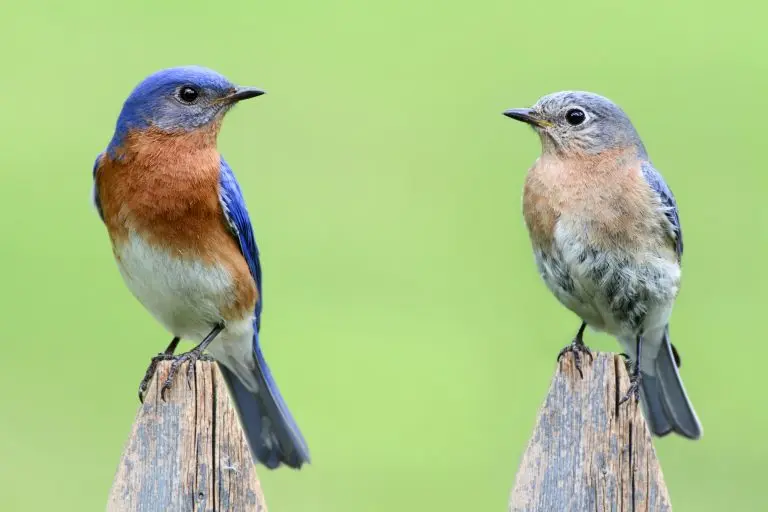
Eastern Bluebirds are spotted all year in Mississippi. They are recorded in 26% of summer checklists and 28% of winter checklists.
Eastern Bluebirds are small thrushes with big, rounded heads, large eyes, and big bellies.
The males are deep blue on the back and a reddish color underneath. Females are grayer above with some blue in the wings and tail and a less vivid orange-brown breast.
- Sialia sialis
- Length: 6.3-8.3 in (16-21 cm)
- Weight: 1.0-1.1 oz (28-32 g)
- Wingspan: 9.8-12.6 in (25-32 cm)
They live all year in southeastern US states, but those that breed in the northern US and southern Canada migrate south.
You can find Eastern bluebirds in meadows, and they can often be spotted perched on wires and posts or low branches, looking for insects.
Eastern Bluebird Song:
Attract Eastern Bluebirds to your backyard by offering mealworms and nest boxes if your yard is pretty open and spacious.
11. Tufted Titmouse
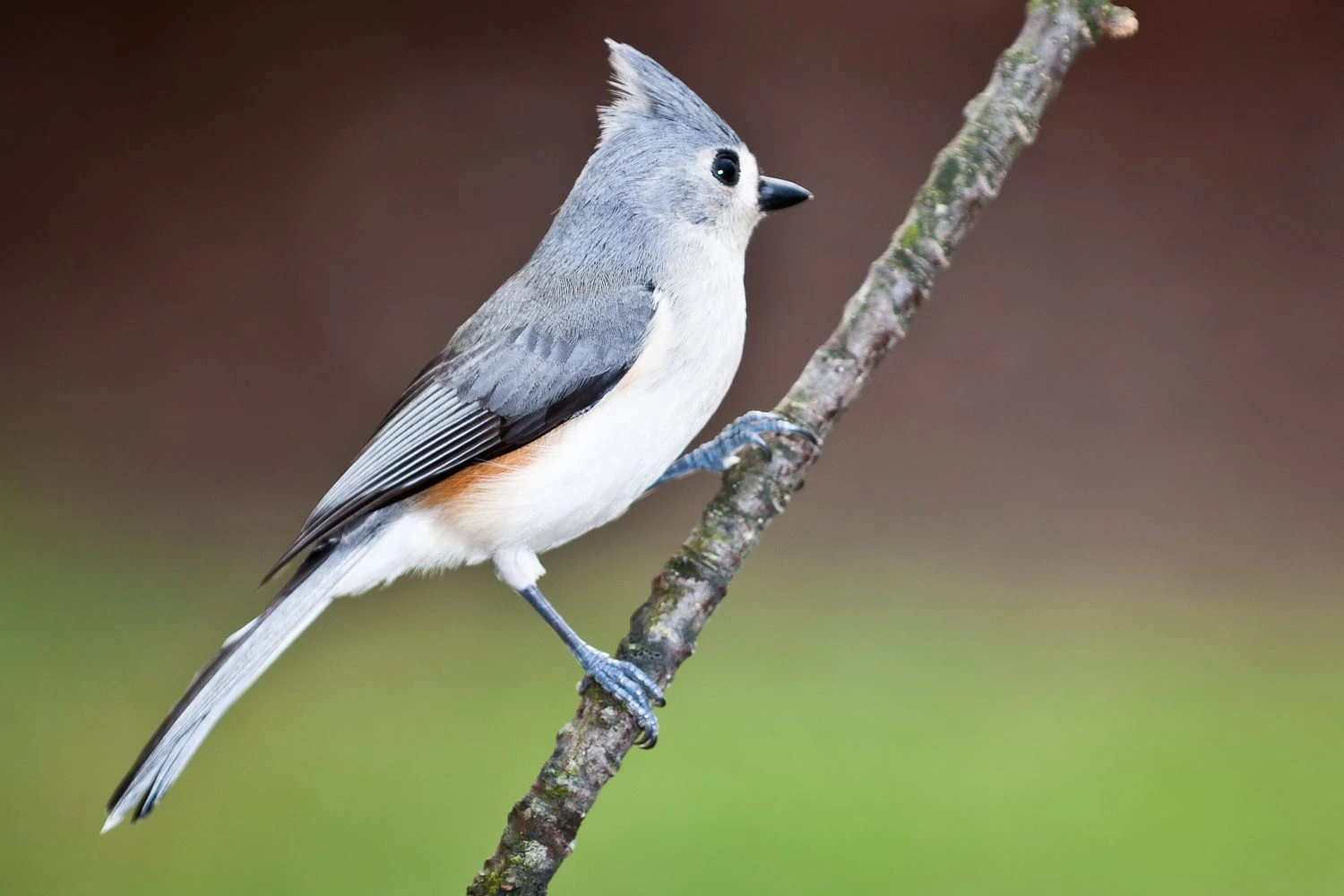
Tufted Titmouses are residents of Mississippi all year and occur in up to 34% of summer checklists and 29% of winter checklists.
Tufted Titmouses are gray on the back and white underneath with a cute gray crest and large eyes. They often flock with chickadees, nuthatches, and woodpeckers.
- Baeolophus bicolor
- Length: 5.5-6.3 in (14-16 cm)
- Weight: 0.6-0.9 oz (18-26 g)
- Wingspan: 7.9-10.2 in (20-26 cm)
Tufted Titmouses live in eastern and southeastern US states all year
You can find Tufted Titmouses in woodlands, parks, and backyard feeders, and they can be assertive over smaller birds, pushing in to get to the food first.
Tufted Titmouses eat mostly insects in summer, including caterpillars, beetles, ants, and wasps, as well as spiders and snails. They will also eat seeds, nuts, and berries and will hoard shelled seeds.
Tufted Titmouse Song:
Attract Tufted Titmouses to your backyard feeders with sunflower seeds, suet, and peanuts on tube feeders or suet cages. They will also eat from platform feeders. You can also try putting up a nest box to attract a breeding pair.
12. Eastern Towhee
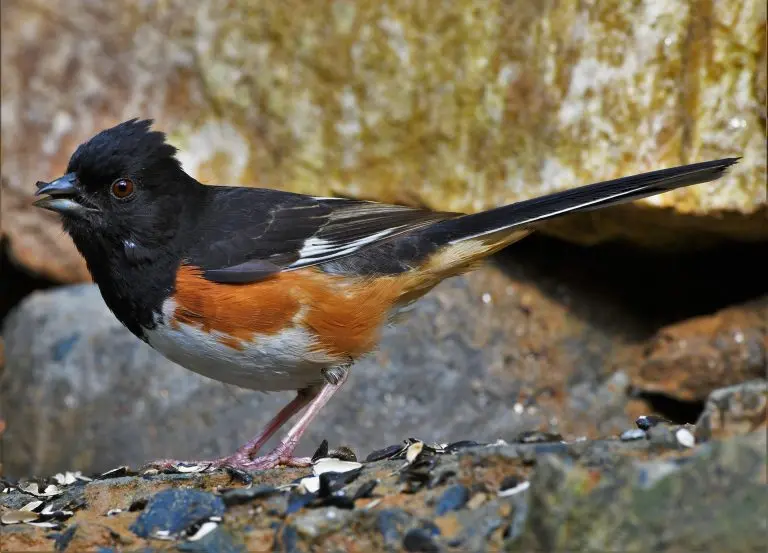
Eastern Towhees stay in Mississippi all year. They appear in 28% of summer checklists and 18% of winter checklists submitted by bird watchers for the state.
Eastern Towhees are striking large sparrows, about the size of Robin, with a black head, throat, and back, reddish sides, long tails, and a white belly in the males. The females are similar but brown instead of black.
- Pipilo erythrophthalmus
- Length: 6.8-8.2 in (17.3-20.8 cm)
- Weight: 1.1-1.8 oz (32-52 g)
- Wingspan: 7.9-11.0 in (20-28 cm)
Eastern Towhees live all year in southeastern US states, but birds further north move south for the winter.
You can find Eastern Towhees rummaging in the undergrowth along the edges of forests and thickets.
Eastern Towhee Song:
Attract Eastern Towhees to your backyard with overgrown borders, and they will also visit platform feeders for black oil sunflower seeds, hulled sunflower seeds, cracked corn, and millet.
13. Barn Swallow
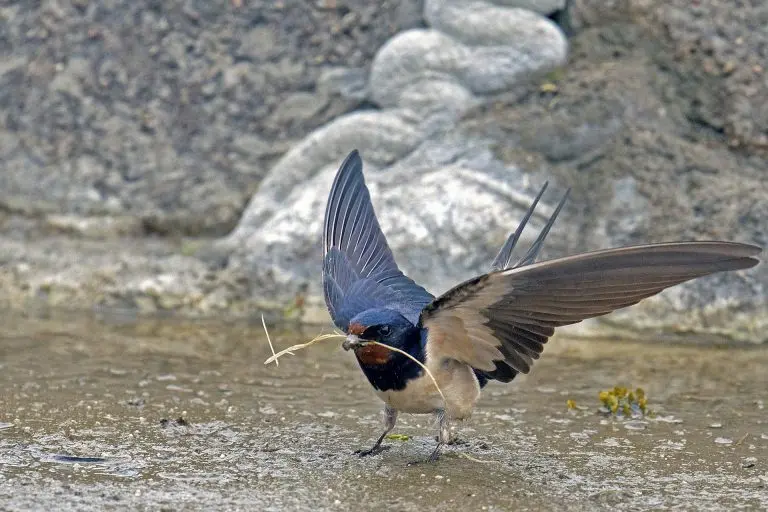
Barn Swallows spend the breeding season in Mississippi and occur in 27% of summer checklists. They are mainly spotted from March to November.
Barn Swallows are small birds with a deep-blue back, wings and tail, and reddish-brown underneath and across the face. Their tail has long outer feathers that give a deep fork. The dark color of their back can make them look black-and-white.
- Hirundo rustica
- Length: 5.9-7.5 in (15-19 cm)
- Weight: 0.6-0.7 oz (17-20 g)
- Wingspan: 11.4-12.6 in (29-32 cm)
Barn Swallows breed in Canada and the US before heading to Central and South America. They can be found flying over meadows, farms, and fields looking for insects and usually build mud nests on man-made structures such as barns.
Attract Barn Swallows by putting up nest boxes or cups, and they may eat ground-up eggshells on a platform feeder.
14. White-throated Sparrow
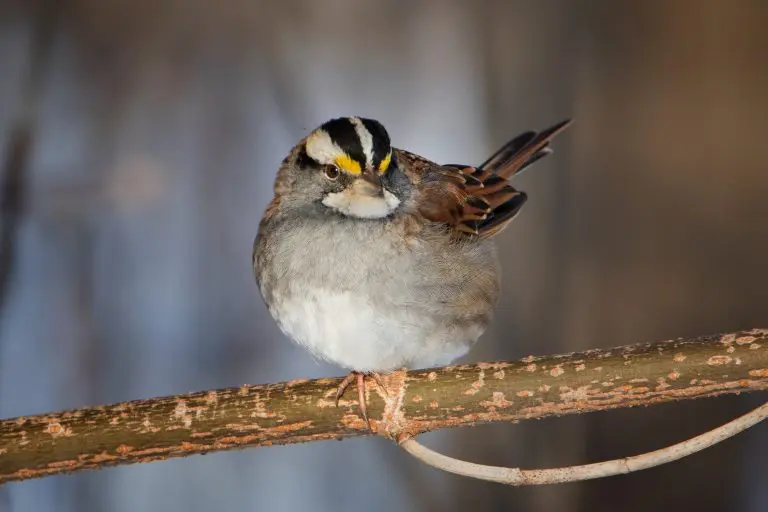
White-throated Sparrows are frequently spotted in Mississippi during winter and appear in 26% of checklists at this time. They stay here from October to May.
White-throated Sparrows have a distinctive black and white striped head, bright white throat, and yellow between the eye and bill. Their backs are brown, and underneath is gray.
- Zonotrichia albicollis
- Length: 6.3-7.1 in (16-18 cm)
- Weight: 0.8-1.1 oz (22-32 g)
- Wingspan: 7.9-9.1 in (20-23 cm)
White-throated Sparrows are migratory birds, breeding mainly in Canada before heading south in winter to eastern and southern US states and the Pacific Coast.
You can find White-throated Sparrows on the ground in forests and woods and along the edges of wooded areas, often in large flocks.
White-throated Sparrows’ diet is mainly seeds of grasses and weeds and fruits such as grape, sumac, mountain ash, blueberry, blackberry, and dogwood. They will also eat many insects from the forest floor, especially in summer.
White-throated Sparrow Song:
Attract White-throated Sparrows to your backyard with millet and black oil sunflower seeds on platform feeders.
Sparrows are known as LBJs (Little brown jobs) but if you want to know more, check out this guide to sparrows in Mississippi.
15. American Robin
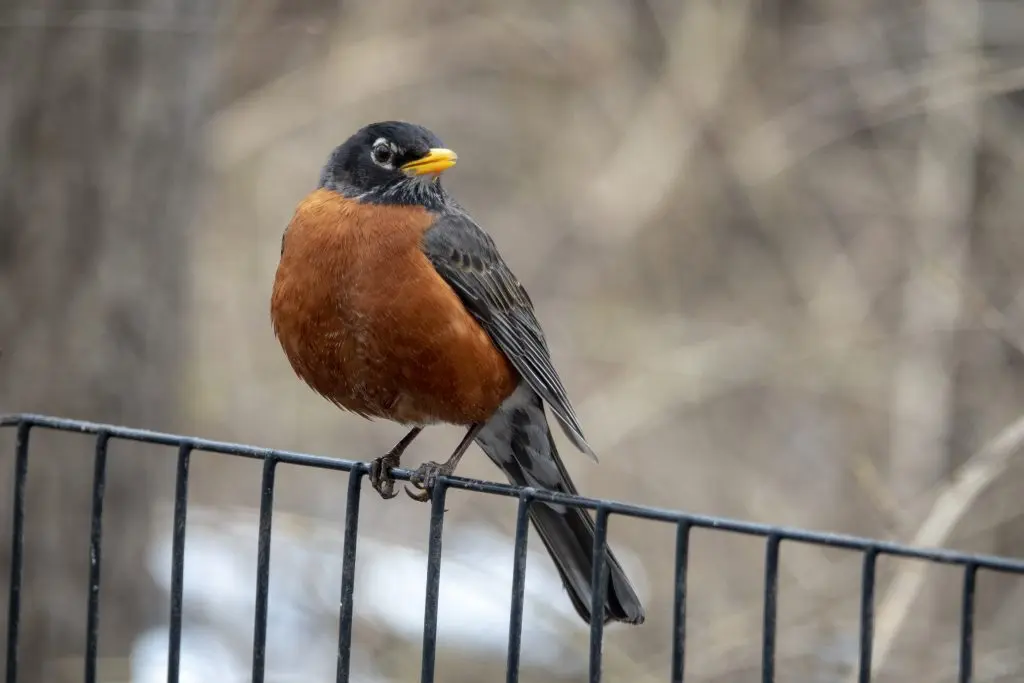
American Robins can be found all year in northern Mississippi, but they are more frequently spotted from December to March. They appear in 14% of summer checklists and 28% of winter checklists for the state.
American Robins are a common sight on lawns eating earthworms. They have black heads and backs with red or orange breasts. They tend to roost in trees in winter, so you are more likely to see them in your backyard from spring.
- Turdus migratorius
- Length: 7.9-11.0 in (20-28 cm)
- Weight: 2.7-3.0 oz (77-85 g)
- Wingspan: 12.2-15.8 in (31-40 cm)
American Robins are residents in the lower 48 and the coast of Western Canada and Alaska. Those that breed in Canada and inland Alaska move south for the winter.
American Robins can be found in many habitats, from woodlands, forests, and mountains to fields, parks, and lawns. They eat earthworms, insects, snails, and fruit.
American Robin Song:
American Robin Call:
Attract American Robins to your backyard with sunflower seeds, suet and peanut hearts, fruit, and mealworms. Platform feeders are best or food scattered on the ground. Also, try planting some native plants that produce berries, such as juniper, sumac, hawthorn, and dogwood.
16. Eastern Phoebe
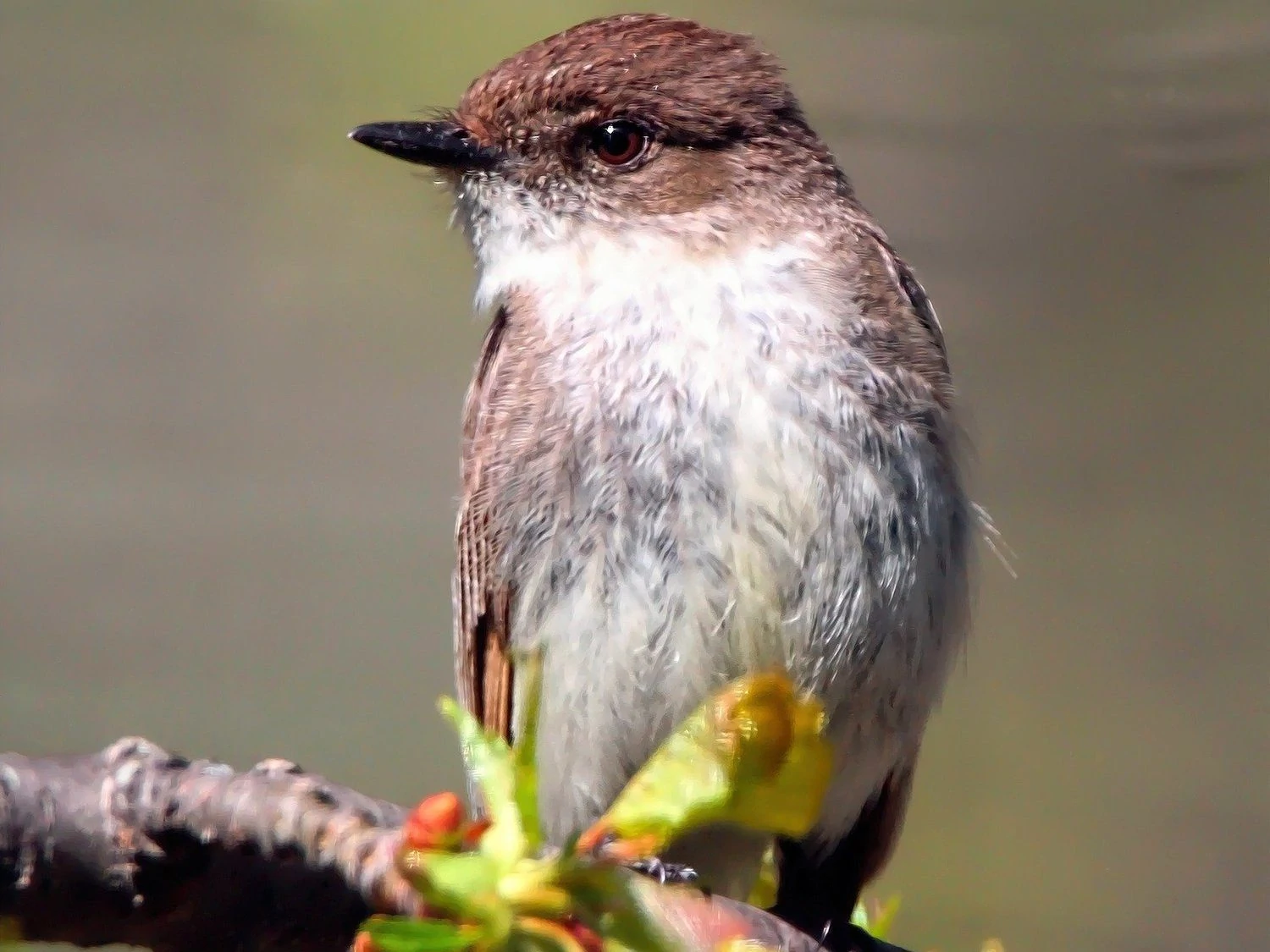
Eastern Phoebes are more frequently spotted during winter in Mississippi, but some stay all year. They appear in 6% of summer checklists and 20% of winter checklists.
Eastern Phoebes are plump songbirds that are grayish-brown on the back and whitish underneath and with a darker head.
- Sayornis phoebe
- Length: 5.5-6.7 in (14-17 cm)
- Weight: 0.6-0.7 oz (16-21 g)
- Wingspan: 10.2-11.0 in (26-28 cm)
Eastern Phoebes are migratory birds, breeding across northeastern and central US states and into Canada before migrating to southeastern US states and Mexico for winter. Some birds may remain all year towards the south of their range.
Eastern Phoebes tend to be found alone in quiet woodland, wagging their tails from low perches rather than in pairs or flocks.
As they are flycatchers, flying insects make up the most of their diet, but they will also eat spiders and other insects, small fruit, and seeds. They often nest on bridges and barns or houses, making a nest out of mud and grass.
Eastern Phoebe Song:
Attract Eastern Phoebes to your backyard by putting up a nest box or native plants that produce berries.
17. American Crow
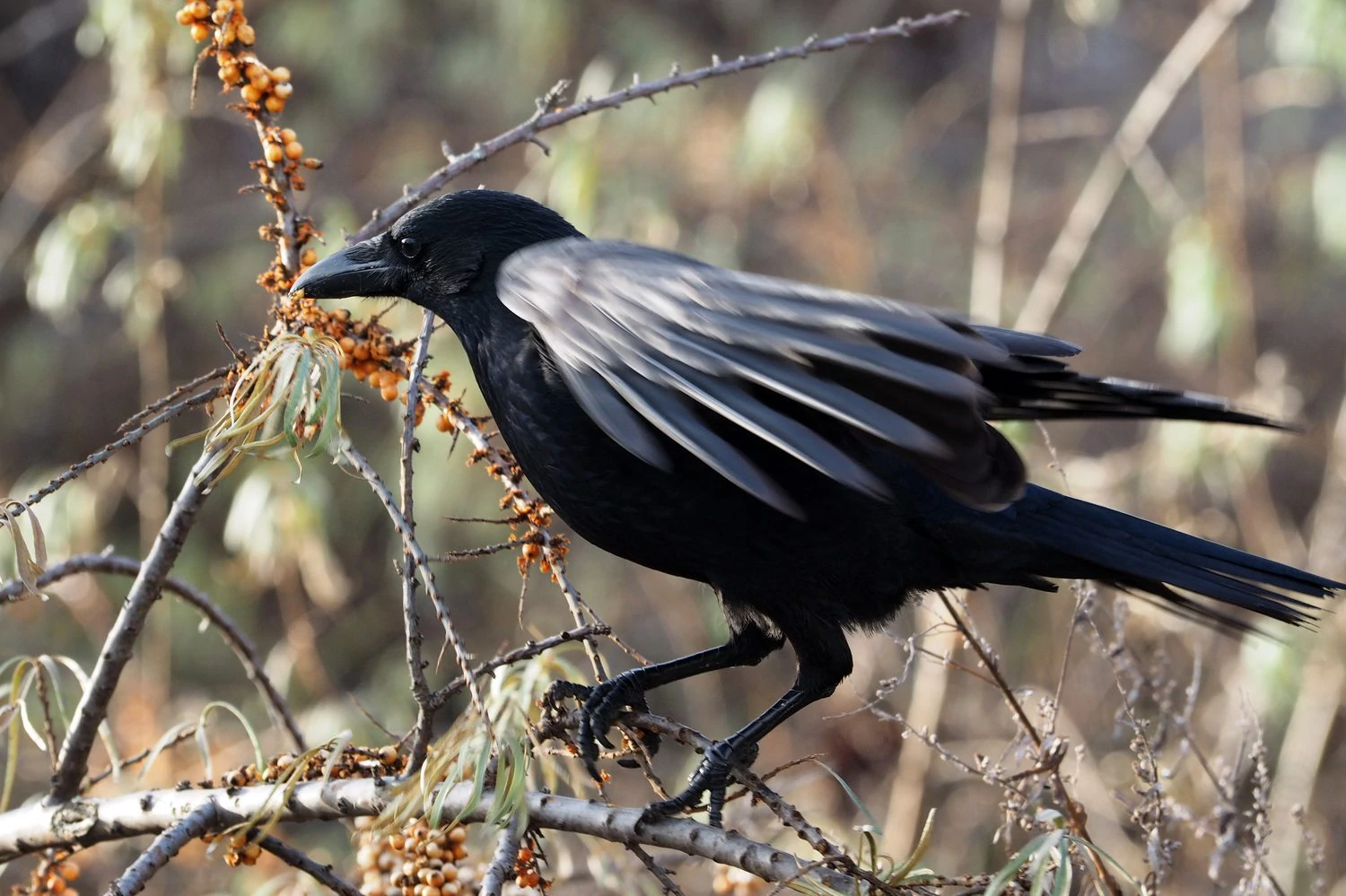
American Crows are very common and found all year in Mississippi. They are spotted in up to 23% of summer and winter checklists for the state.
American crows are large all-black birds that make a hoarse, cawing sound.
- Corvus brachyrhynchos
- Length: 15.8-20.9 in (40-53 cm)
- Weight: 11.2-21.9 oz (316-620 g)
- Wingspan: 33.5-39.4 in (85-100 cm)
American Crows are residents all year in most of the lower 48 and the Pacific Coast in Canada and Alaska. Those that breed in Canada and the northern Midwest migrate south for winter.
They are common birds found in most habitats, including treetops, woods, fields, beaches, or towns.
They eat most things and usually feed on the ground, eating earthworms, insects, seeds, and fruit. They also eat fish, young turtles, mussels, and clams and will even eat eggs and nestlings of many species of birds.
In winter, American Crows gather in large numbers of up to two million crows to sleep in noisy communal roosts.
American Crow Call:
Attract American Crows to your backyard by scattering peanuts, but they can become a nuisance as they are attracted by garbage or pet food if left out.
18. American Goldfinch
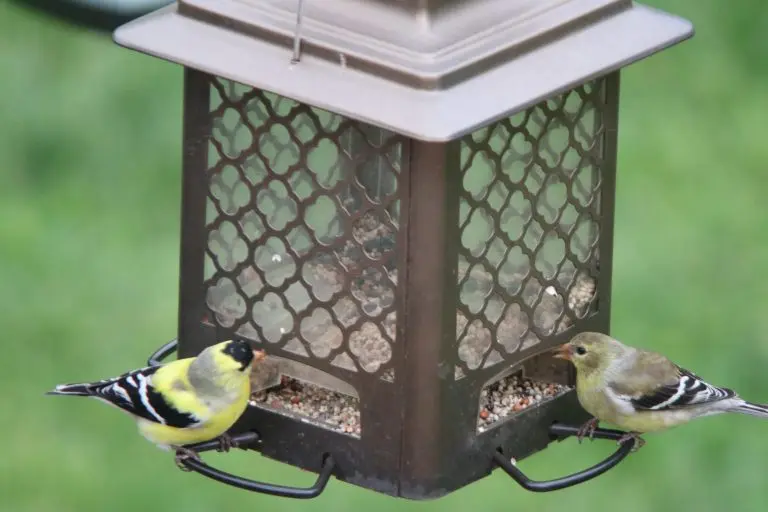
American Goldfinches are mainly spotted during winter in southern Mississippi. However, some stay all year in the north of the state. They are recorded in 3% of summer checklists and 25% of winter checklists for the state.
American Goldfinches are popular birds with the males bright yellow and black coloring in spring. The females are duller brown, as are males in winter.
- Spinus tristis
- Length: 4.3-5.1 in (11-13 cm)
- Weight: 0.4-0.7 oz (11-20 g)
- Wingspan: 7.5-8.7 in (19-22 cm)
American Goldfinches can be found in most of North America and are usually resident all year. However, those that breed in Canada and the Midwest migrate to southern US States for winter.
They can be found in weedy fields and overgrown areas foraging for sunflower, thistle, and aster plants. They are also common in suburbs, parks, and backyards.
American Goldfinch Song:
Attract American Goldfinches to your backyard by planting thistles and milkweed. They will visit most bird feeders and prefer sunflower seed and nyjer seed.
There are so many yellow birds in Mississippi that you will spot, especially in spring.
19. Indigo Bunting
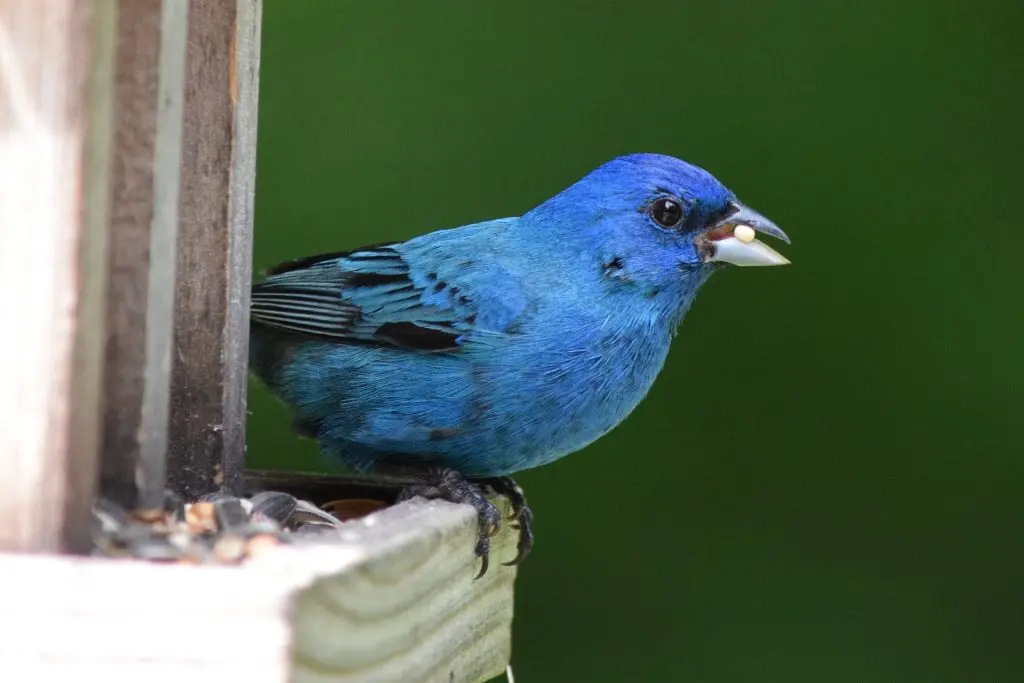
Indigo Buntings are often spotted in Mississippi during summer and occur in 26% of checklists at this time. They are mainly seen from April to November, but a few hang around all year.
Indigo Buntings are small birds, with the males being bright blue with streaks of black in the wings and tail, females are brown.
- Passerina cyanea
- Length: 4.7-5.1 in (12-13 cm)
- Weight: 0.4-0.6 oz (12-18 g)
- Wingspan: 7.5-8.7 in (19-22 cm)
Indigo Buntings migrate far from breeding grounds in eastern US states, southeastern Canada, and southern US states to winter grounds in Florida, Central and South America, and the Caribbean.
You can find Indigo Buntings in weedy fields and shrubby areas foraging for seeds and insects.
Indigo Bunting Song:
Attract Indigo Buntings to your backyard with small seeds such as nyjer and thistle.
20. Downy Woodpecker
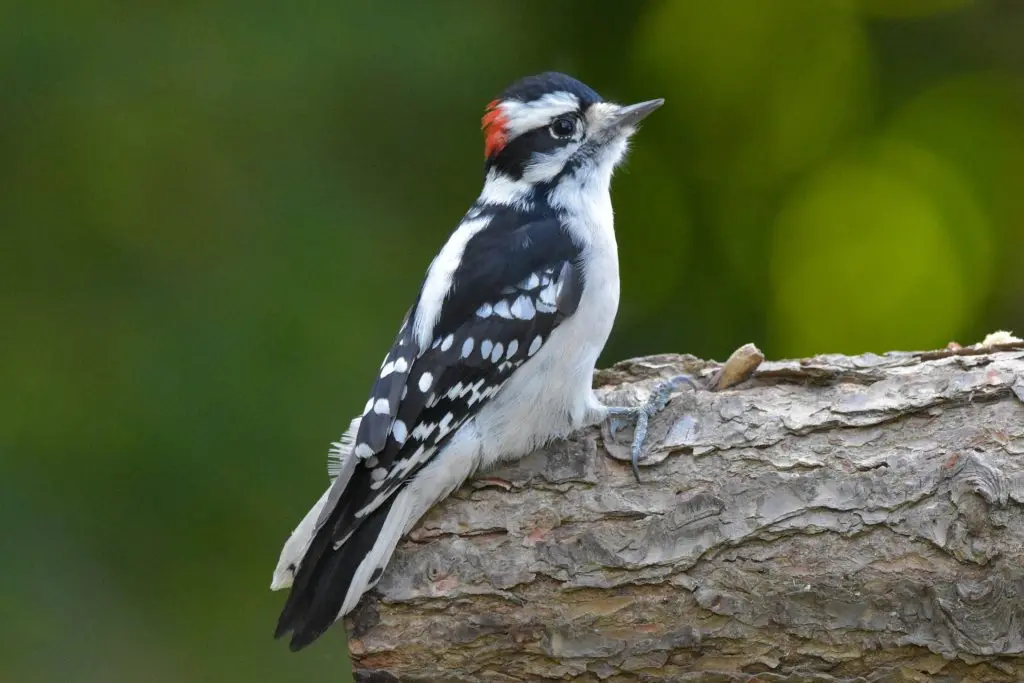
Downy Woodpeckers can be found all year in Mississippi. They are recorded in 20% of summer and winter checklists.
Downy Woodpeckers are small birds that are common at backyard feeders. They are often mixed in with other birds, such as chickadees and nuthatches.
They have black and white coloring with a red patch at the back of their heads. They look similar to the Hairy Woodpecker but smaller.
- Dryobates pubescens
- Length: 5.5-6.7 in (14-17 cm)
- Weight: 0.7-1.0 oz (21-28 g)
- Wingspan: 9.8-11.8 in (25-30 cm)
Downy Woodpeckers do not migrate and can be spotted in most states and provinces, except the north of Canada.
You can find Downy woodpeckers in woodlots, along streams, city parks, and backyards, and they eat mainly insects and beetle larvae but also berries, acorns, and grains.
Downy Woodpecker Call:
Attract Downy Woodpeckers to your backyard with their favorite treat of suet, but they will also eat black oil sunflower seeds, millet, and peanuts on platform feeders.
21. European Starling
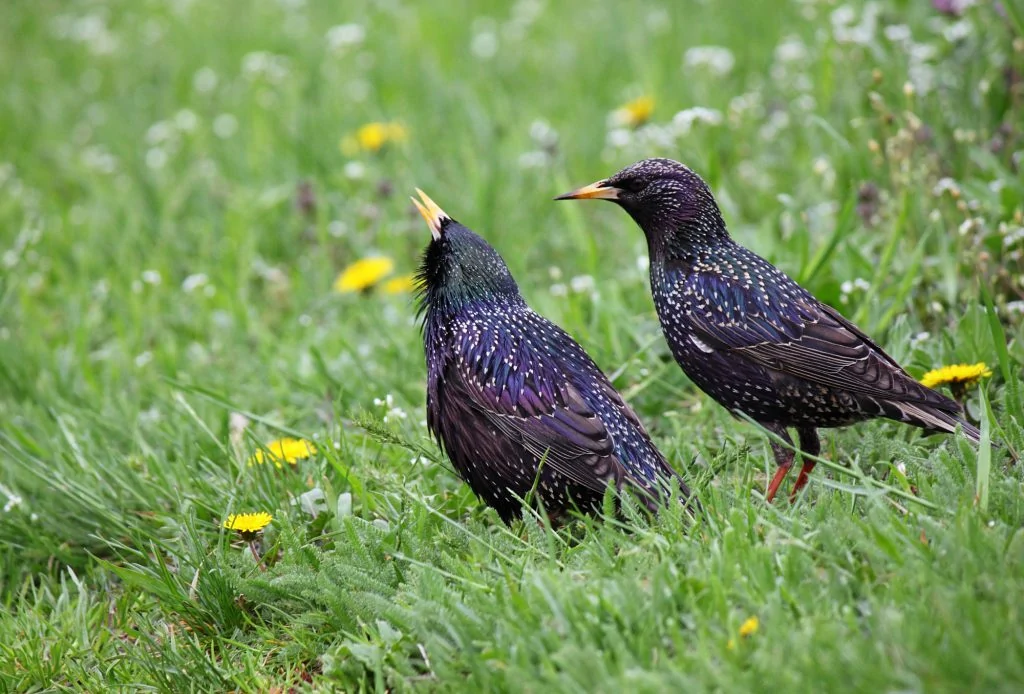
European Starlings are considered introduced species in Mississippi that can be seen in the state all year and do not migrate. They appear in 19% of summer checklists and 16% of winter checklists.
European Starlings are not native but are now one of the most numerous songbirds. They are stocky black birds with iridescent purple, green, and blue tones.
- Sturnus vulgaris
- Length: 7.9-9.1 in (20-23 cm)
- Weight: 2.1-3.4 oz (60-96 g)
- Wingspan: 12.2-15.8 in (31-40 cm)
European Starlings live in all North America, except the north of Canada and Alaska.
They are considered a pest by some due to their aggressive behavior. These birds fly in large, noisy flocks and can be seen perched in groups on the top of trees or flying over fields.
European Starling Calls:
Starlings predominantly eat insects, including beetles, flies and caterpillars, earthworms, and spiders. However, they also eat fruit, including cherries, holly berries, mulberries, Virginia Creeper, sumac, blackberries, and grains and seeds.
Attract European Starlings to your backyard feeders with black oil sunflower seeds, suet, cracked corn, and peanuts.
22. House Finch
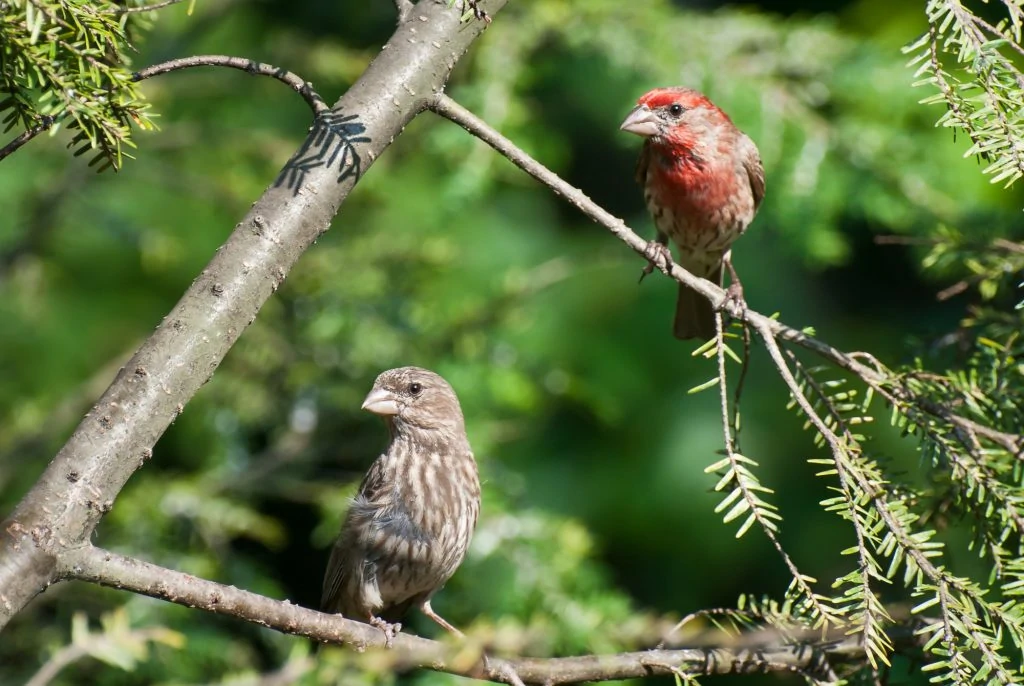
House Finches are residents of Mississippi all year. They do not migrate and appear in 18% of summer checklists and 16% of winter checklists submitted by bird watchers for the state.
House Finches males have a red head and breast, and the rest of their bodies are mainly brown-streaked. Females are brown-streaked all over.
- Haemorhous mexicanus
- Length: 5.1-5.5 in (13-14 cm)
- Weight: 0.6-0.9 oz (16-27 g)
- Wingspan: 7.9-9.8 in (20-25 cm)
Originally only in western US states, House Finches were introduced to eastern US states and have done very well, even pushing out the Purple Finch.
They can be found in parks, farms, forest edges, and backyard feeders in noisy groups that are hard to miss.
House Finch Song:
House Finch Call:
Attract House Finches to backyard feeders with black oil sunflower seeds or nyjer seeds in tube feeders or platform feeders.
There are a surprising number of finches in Mississippi that you can get to know.
23. Ruby-throated Hummingbird
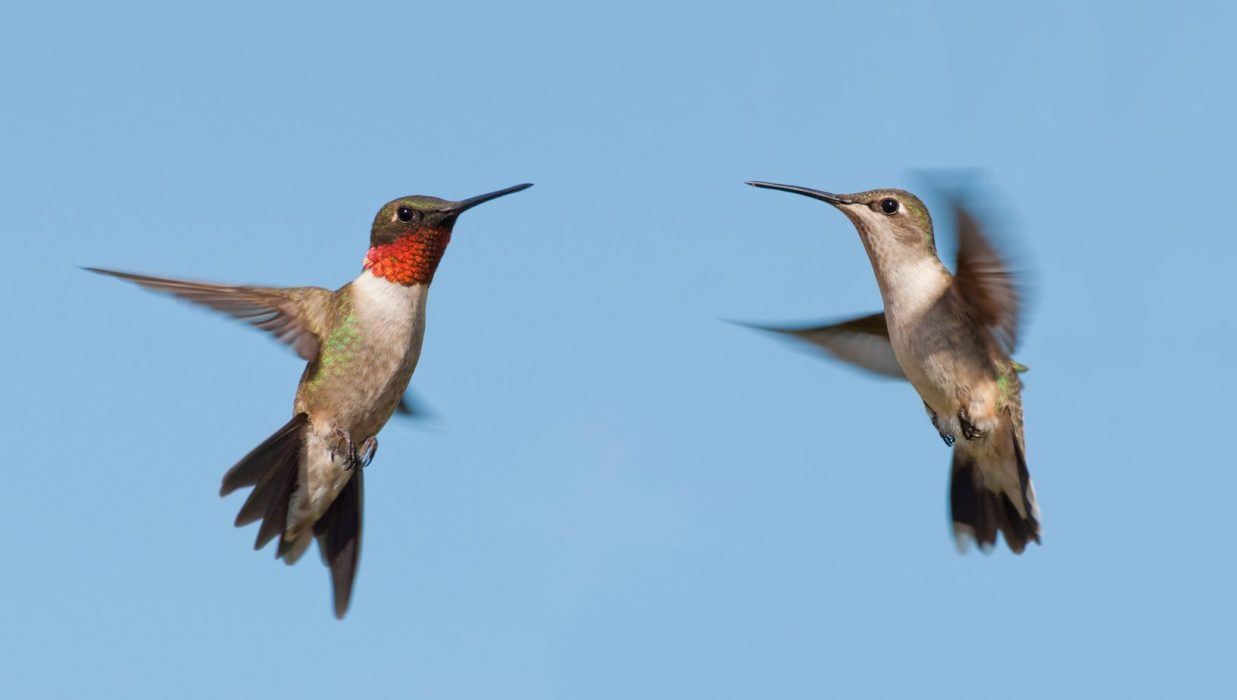
Ruby-throated Hummingbirds are bright green on the back and crown, with a gray-white underside and the males have an iridescent red throat. Female Ruby-throated Hummingbirds lack the red throat, but they are green on the back and white underneath with brownish crowns and sides.
- Archilochus colubris
- Length: 2.8-3.5 in (7-9 cm)
- Weight: 0.1-0.2 oz (2-6 g)
- Wingspan: 3.1-4.3 in (8-11 cm)
Ruby-throated Hummingbirds are the only breeding hummingbird in eastern North America. They migrate south over the Gulf of Mexico or through Texas to Central America for winter.
Ruby-throated Hummingbirds start arriving in the far south in February, and they may not arrive in northern states and Canada until May for breeding. They begin to migrate south in August and September.
Male Ruby-throated Hummingbirds can be aggressive in their defense of flowers and feeders, and they do not stick around long after mating and may migrate by early August.
These tiny birds zip from one nectar source to the next or catch insects in midair or from spider webs. They occasionally stop on a small twig, but their legs are so short they cannot walk, only shuffle along a perch.
In summer, flowering gardens or woodland edges are the best places to find them when out. They are also common in towns, especially at nectar feeders.
Ruby-throated Hummingbird Wingbeat/Call:
Attract Ruby-throated Hummingbirds to your backyard with homemade nectar, and you can even attract hummingbirds with shade-loving plants or glorious hanging plants.
If you get a buzz out of hummingbirds, then check out all the hummingbirds in Mississippi and when is best to spot them.
24. Pine Warbler
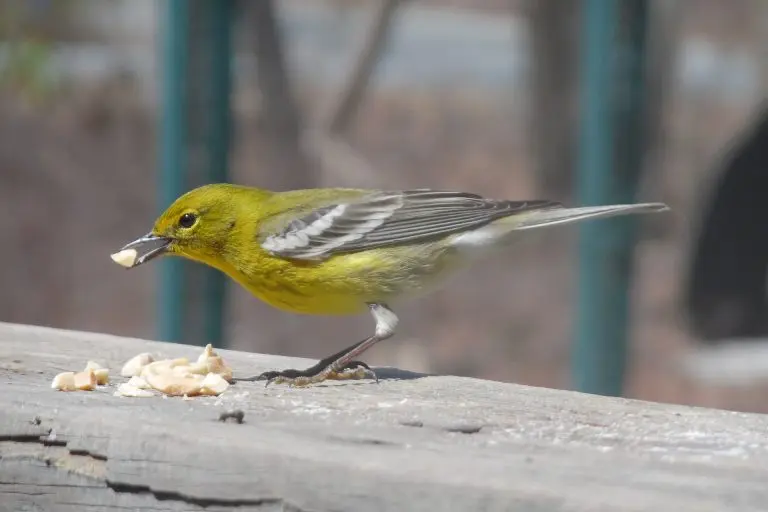
Pine Warblers can be spotted all year in Mississippi. They appear in 13% of summer checklists and 16% of winter checklists submitted by bird watchers for the state.
Pine Warblers are small plump yellow birds with olive backs, white lower bellies, and gray wingbars. Females can appear browner and have more white on the belly.
- Setophaga pinus
- Length: 5.1-5.5 in (13-14 cm)
- Weight: 0.3-0.5 oz (9-15 g)
- Wingspan: 7.5-9.1 in (19-23 cm)
Pine Warblers breed in northeastern US states before heading to southeastern US states. Some remain all year in southeastern US states.
You can find Pine Warblers in pine forests, as their name would suggest, often high up in the trees. They eat caterpillars, beetles, spiders, and other insects and larvae, and when the weather is colder, they will eat fruit and seeds.
Nests of Pine Warblers are as you would expect, in pine trees! They are made from twigs, bark, pine needles, and grass and bound together with spider silk, and lined with feathers and animal hair. They lay up to five eggs which take up to two weeks to hatch and another ten days for the young to leave the nest.
Attract Pine Warblers to your yard with tube feeders and platform feeders with millet, cracked corn, sunflower seeds, peanut hearts, and suet. Also plant native fruits and vines such as bayberry, grape, sumac, and Virginia creeper.
25. Common Grackle
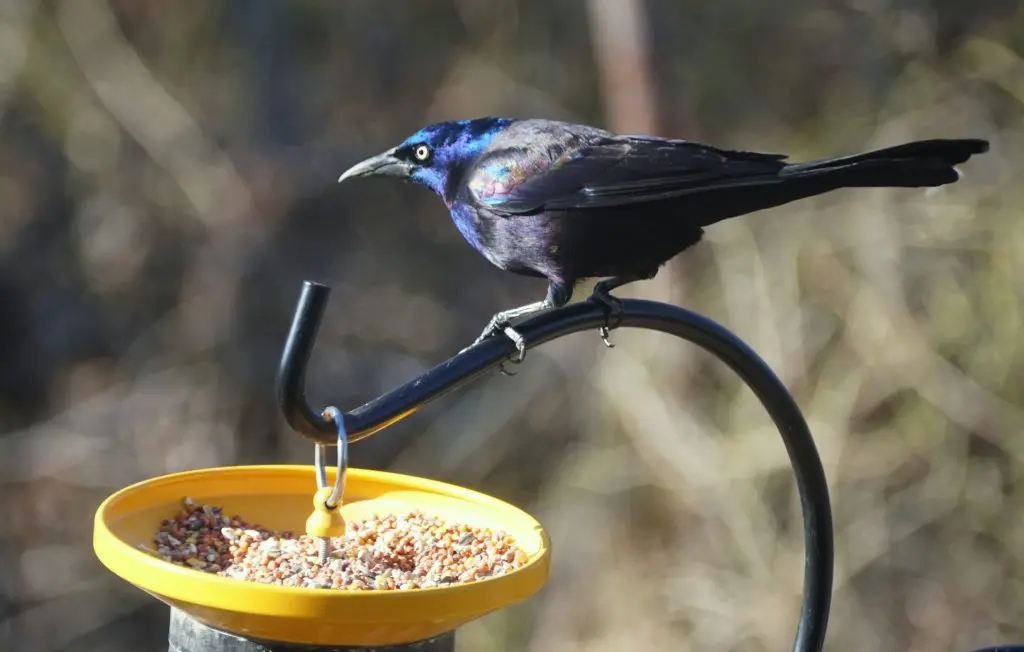
Although considered near-threatened species, Common Grackles have been spotted in Mississippi all year and appear in 19% of summer checklists and 9% of winter checklists.
The Common Grackle is a blackbird taller and longer tailed than a typical blackbird with glossy iridescent bodies.
- Quiscalus quiscula
- Length: 11.0-13.4 in (28-34 cm)
- Weight: 2.6-5.0 oz (74-142 g)
- Wingspan: 14.2-18.1 in (36-46 cm)
Common Grackles are resident all year in southeastern states, but those that breed in Canada and the Midwest migrate south.
They eat many crops but mostly corn, and they gather in noisy groups high up in trees. Unfortunately, they will also eat garbage and so can be a nuisance. Their habitat is varied and includes open woodlands, marshes, parks, and fields.
They may gather in their millions in winter to forage and roost, mixed in with other species of blackbirds.
Common Grackle Call:
Attract more Common Grackles to your backyard with mixed grain and seed sprinkled on the ground or platform feeders.
26. Brown-headed Cowbird
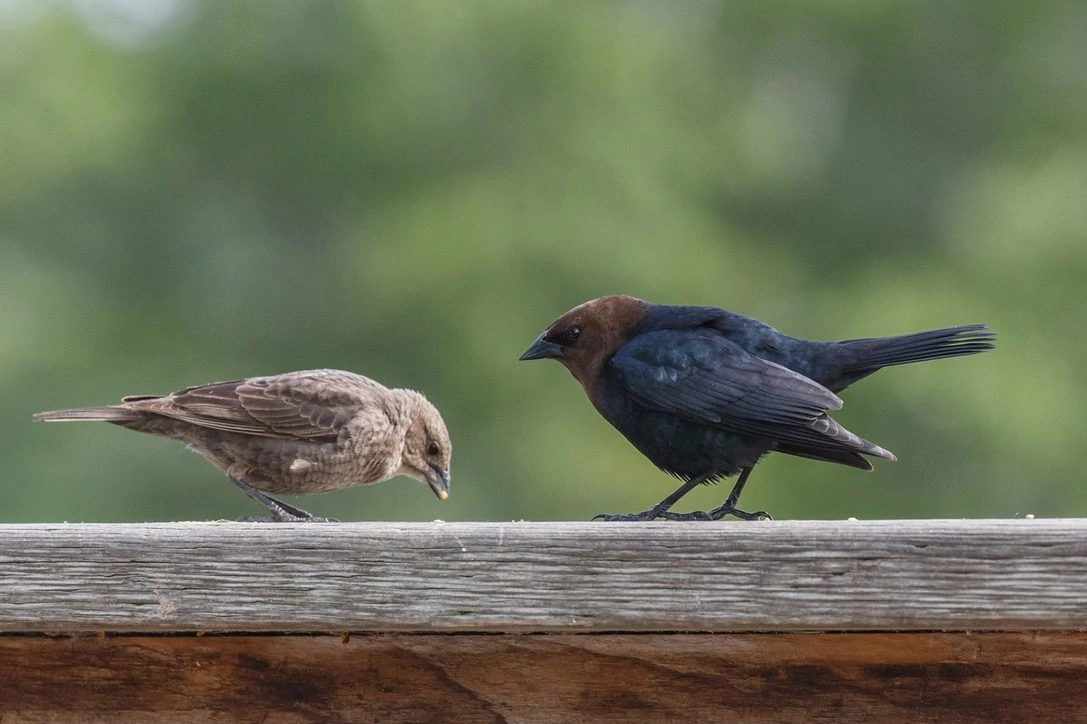
Brown-headed Cowbirds are more often spotted during summer, from February to July, but some are residents of Mississippi all year. They appear in 21% of summer checklists and 7% of winter checklists.
Males Brown-headed Cowbirds are larger than females, with black-bodies, brown heads, and short tails. Female Brown-headed Cowbirds are brown all over with slight streaking.
- Molothrus ater
- Length: 76.3-8.7 in (19-22 cm)
- Weight: 1.3-1.8 oz (42-50 g)
- Wingspan: 14.2 in (36 cm)
Brown-headed Cowbirds remain all year in eastern US states, southern US states, and along the Pacific Coast. However, those that breed in northern and western US states and Canada migrate south for winter.
Brown-headed Cowbird Song:
They are often considered a nuisance because they are parasite birds that destroy the eggs of smaller songbirds so they can lay their eggs in the nest and have the bird foster their chicks.
27. Ruby-crowned Kinglet
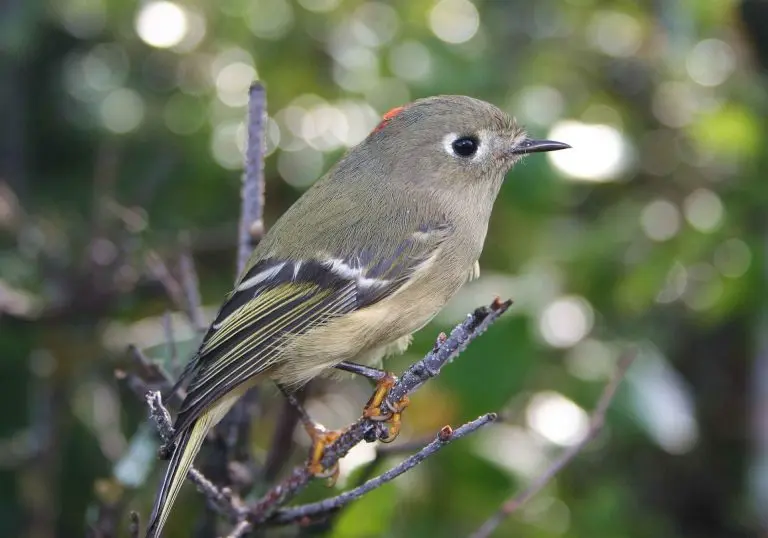
Ruby-crowned Kinglets spend winter in Mississippi and are spotted from September to mid-May. They are recorded in 18% of winter checklists for the state.
Ruby-crowned Kinglets are small songbirds that are olive-green, and the males have a brilliant red crown that is usually flat, so hard to see.
- Corthylio calendula
- Length: 3.5-4.3 in (9-11 cm)
- Weight: 0.2-0.3 oz (5-10 g)
- Wingspan: 6.3-7.1 in (16-18 cm)
Ruby-crowned Kinglets breed in Canada and the mountainous west before migrating to southern and southwestern US states and Mexico for the winter.
Ruby-crowned Kinglets can be hard to spot as they are fast-moving quiet birds that flit around in the foliage of lower branches and shrubs and trees looking for spiders and insects.
Ruby-crowned Kinglet Song:
Attract Ruby-crowned Kinglets with suet or platform feeders with hulled sunflower seeds, peanut hearts, and mealworms.
28. Red-headed Woodpecker
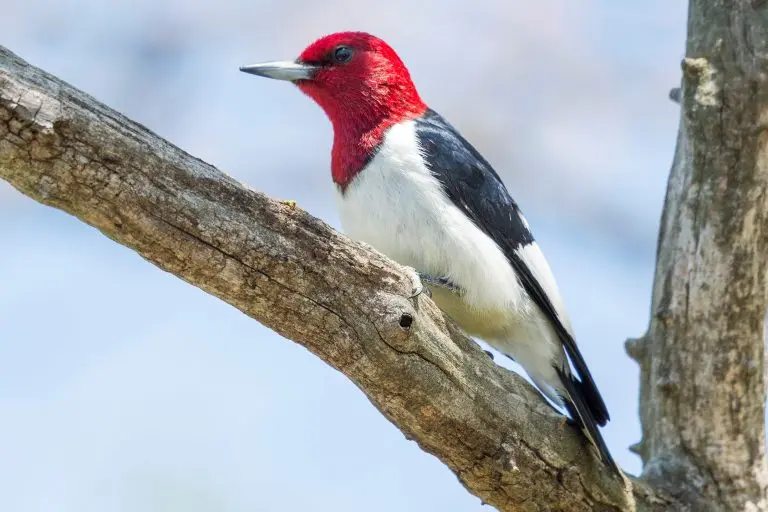
Red-headed Woodpeckers can be found all year in Mississippi but are more common from April to October. They appear in 17% of summer checklists and 7% of winter checklists.
Red-headed Woodpeckers are medium-sized with powerful spike bills and with their bright red-heads and black and white bold markings, these woodpeckers are one of the easiest to identify. . They have white undersides, black backs, large white bands on the wings, and short tails.
- Length: 7.5-9.1 in (19-23 cm)
- Weight: 2.0-3.2 oz (56-91 g)
- Wingspan: 16.5 in (42 cm)
Red-headed Woodpeckers can be found in Eastern and Central US states and into southern Canada. Those in the north and east of the range may migrate further east and south depending on acorn crops.
Red-headed Woodpeckers can fiercely defend their territories, even removing or destroying the eggs of other birds or ducks. They catch insects in flight as well as in crevices like other woodpeckers.
They also eat plant materials such as seeds, nuts, and berries. Red-headed Woodpeckers will also take nestlings or eggs from other birds and sometimes mice.
You can find Red-headed Woodpeckers in open woodlots, farms, dead timber in swamps, or pine savannas. Sometimes they visit backyard bird feeders.
Attract Red-headed Woodpeckers to your backyard feeders with suet
29. Northern Flicker
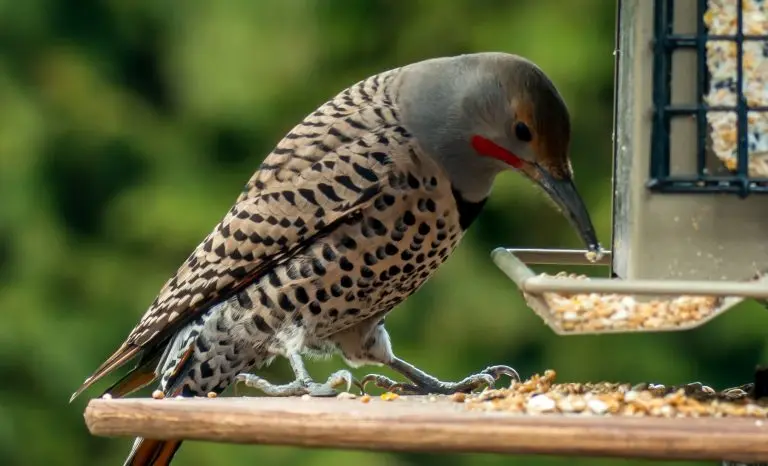
Northern Flickers are spotted in Mississippi all year, but they are spotted more during winter. They appear in 4% of summer checklists and 13% of winter checklists.
Northern Flickers are large brown woodpeckers with black spots and a white patch on their rump in flight, plus a red nape of the neck in the males.
Northern Flickers have red or yellow flashes in the wings and tail depending on where they originate. Red-shafted birds live in the west, and yellow-shafted birds live in the east.
- Colaptes auratus
- Length: 11.0-12.2 in (28-31 cm)
- Weight: 3.9-5.6 oz (110-160 g)
- Wingspan: 16.5-20.1 in (42-51 cm)
Northern Flickers can be spotted across the US all year and in Canada during summer. Those that breed in Canada migrate south for the winter.
Northern Flickers mainly eat ants, beetles, fruits, and seeds, and they can often be seen on the ground digging with their curved bill.
Northern flicker Call:
Attract Northern Flickers to your backyard with suet.
30. House Sparrow
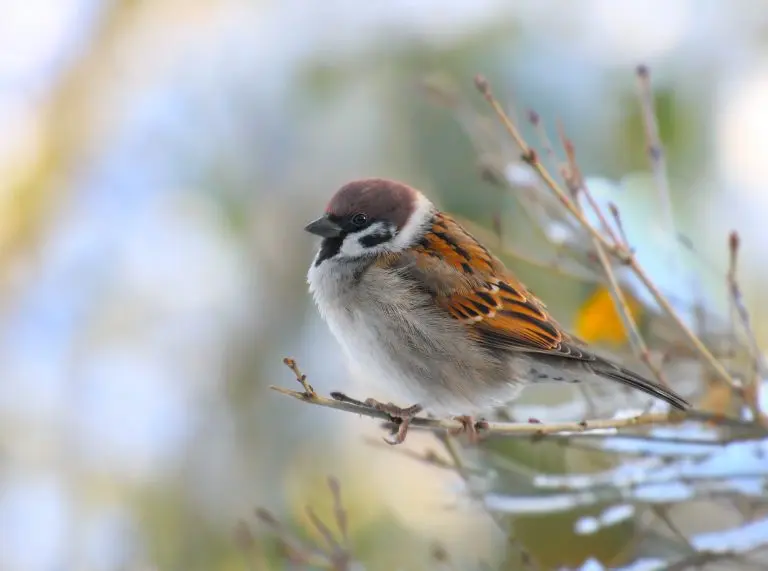
House Sparrows are an introduced species in Mississippi that can be spotted here all year. They do not migrate and occur in 13% of summer checklists and 11% of winter checklists for the state.
The House Sparrow is another introduced species that has done very well and is now one of the most common birds. They have gray and brown heads and white cheeks. Their backs are black and brown, and their bellies are gray.
- Passer domesticus
- Length: 5.9-6.7 in (15-17 cm)
- Weight: 0.9-1.1 oz (27-30 g)
- Wingspan: 7.5-9.8 in (19-25 cm)
House Sparrows live in the US and Southern Canada all year.
You can find them near houses and buildings, and they can be pretty tame, and they may even eat out of your hand.
House Sparrows eat mostly grain and seed as well as discarded food. They can be considered a pest because they are non-native, but they are found in backyards even if you do not feed them.
House Sparrow Song:
Attract House Sparrows to your backyard feeders with most kinds of birdseed, including millet, corn, and sunflower seeds.
Brown birds are often overlooked but once you get to know a few you are hooked so get studying all the brown birds in Mississippi.
31. Chipping Sparrow
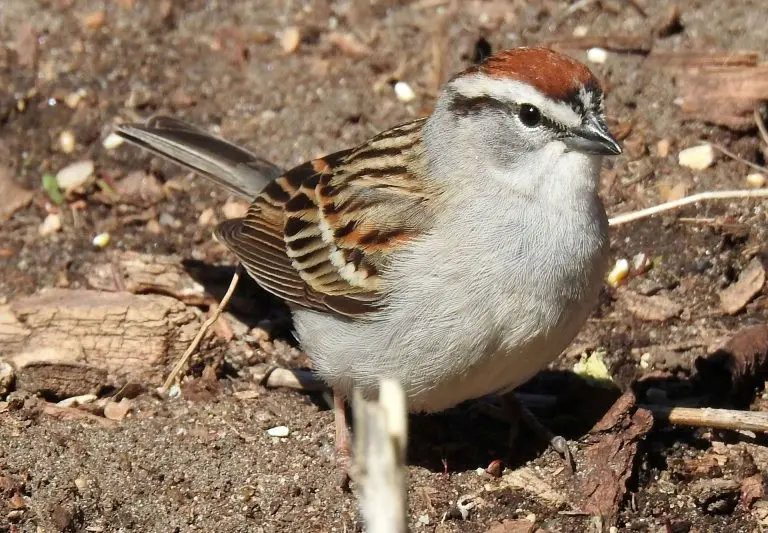
Chipping Sparrows can be spotted in Mississippi all year, but they are more common during winter, from November to April. They are recorded in 6% of summer checklists and 15% of winter checklists.
Chipping Sparrows are slender, long-tailed birds with a grayish belly and brown and black-streaked back, with a rusty crown and black eye line. In winter, the colors are more subdued.
- Spizella passerina
- Length: 4.7-5.9 in (12-15 cm)
- Weight: 0.4-0.6 oz (11-16 g)
- Wingspan: 8.3 in (21 cm)
Chipping Sparrows spend their summer breeding in the US and Canada before flying to Mexico and Florida for winter. Some remain all year in the southern states.
You can find Chipping Sparrows in small flocks on open ground and will come to backyards for many kinds of birdseed.
Chipping Sparrow Song:
Attract Chipping Sparrows to your backyard with seeds or cracked corn on open feeders such as hoppers or platforms.
32. Common Yellowthroat
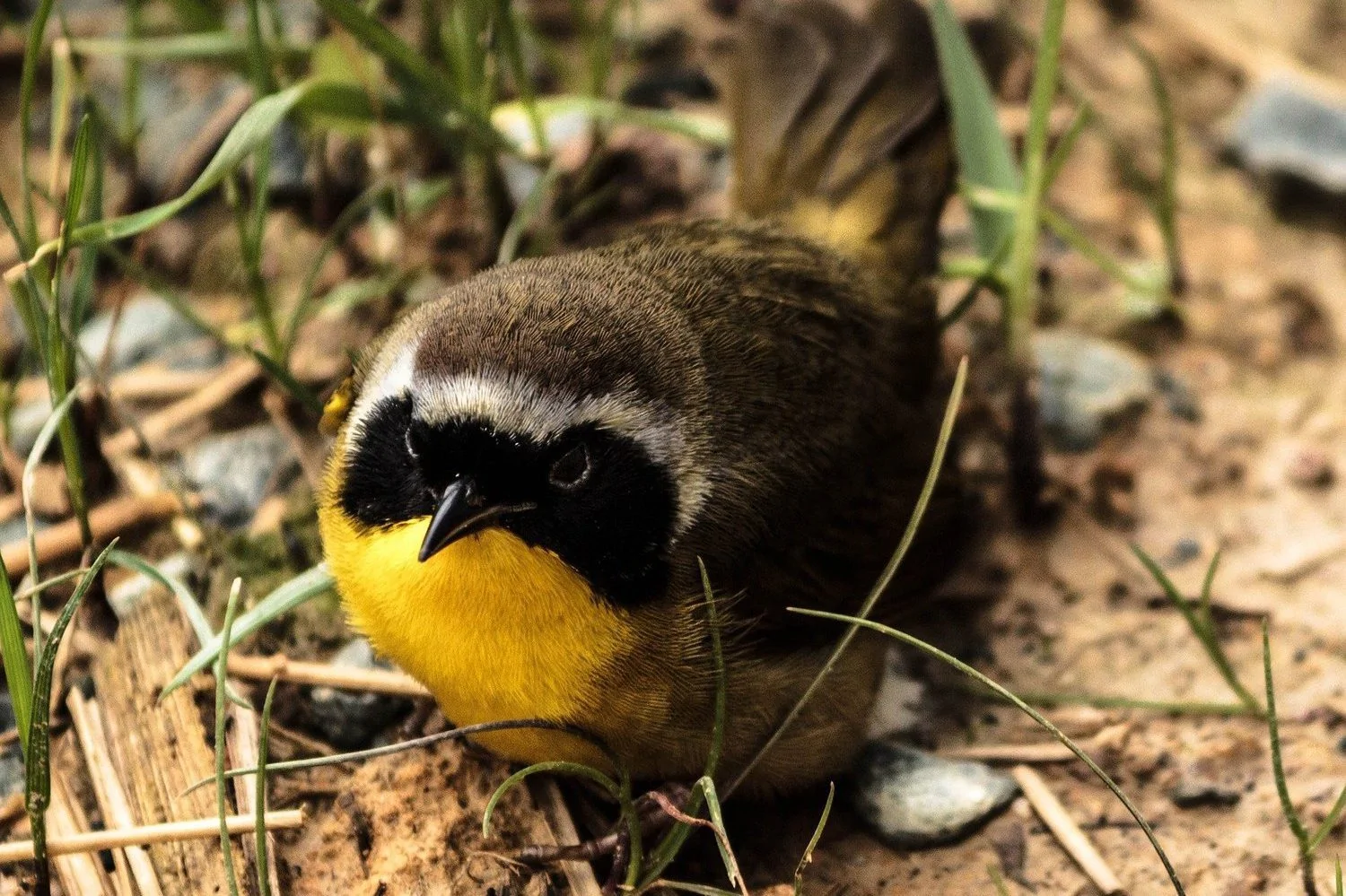
Common Yellowthroats can be spotted all year in southern Mississippi, but they are more often seen in the north of the state during the breeding season. They appear in 16% of summer checklists and 3% of winter checklists for the state.
Common Yellowthroats are small songbirds that are brownish on the back and bright yellow underneath, with long tails. The males have a black masks across their faces. The brightness of the yellow can vary geographically, and they may be more olive in parts underneath.
- Geothlypis trichas
- Length: 4.3-5.1 in (11-13 cm)
- Weight: 0.3-0.3 oz (9-10 g)
- Wingspan: 5.9-7.5 in (15-19 cm)
Common Yellowthroats spend the summer breeding over most of North America, except Alaska and northern Canada. Some remain all year along the Gulf Coast and Pacific Southwest. Then, they migrate south for winter.
You can find Common Yellowthroats often in marshy or wetland areas and brushy fields living in thick, tangled vegetation.
Common Yellowthroat Song:
Attract Common Yellowthroats to large backyards with dense vegetation and native plants to attract insects.
Common Birds at Different Times of Year in Mississippi
The birds that are attracted to backyards in Mississippi change throughout the year. The lists below show the backyard birds most commonly seen at different times of the year in Mississippi.
These are the backyard birds most often seen in Mississippi that may visit your lawn or feeders. In addition, they are the birds that appear most frequently on state checklists on ebird. The data combines birds most commonly spotted in Mississippi in summer (June and July) and winter (December and January).
Birds that are not often seen at feeders or backyards were removed to give you the birds in Mississippi you are most likely to see from home.
This data mix ensures that whatever time of year you are bird-watching in Mississippi, these are the birds you will most likely spot at feeders or on your lawn.
Backyard Birds in Mississippi in Summer:
Northern Cardinal 60.1%
Northern Mockingbird 50.7%
Blue Jay 49.2%
Mourning Dove 48.7%
Carolina Wren 42.1%
Red-bellied Woodpecker 36.9%
Red-winged Blackbird 34.3%
Tufted Titmouse 34.0%
Carolina Chickadee 29.0%
Eastern Towhee 28.3%
Backyard Birds in Mississippi in Winter:
Northern Cardinal 51.0%
Blue Jay 41.5%
Northern Mockingbird 36.9%
Yellow-rumped Warbler 36.0%
Red-bellied Woodpecker 34.6%
Carolina Wren 34.3%
Mourning Dove 33.9%
Carolina Chickadee 33.7%
Tufted Titmouse 29.0%
Eastern Bluebird 28.3%
Best Bird Feeders to Attract Birds
A variety of different bird feeders will attract the most species of birds in Mississippi to your backyard.
- Tube Feeders can be filled with different types of birdseed, and depending on the seed, different birds will be attracted. Black oil sunflower seeds attract Goldfinches, Chickadees, Woodpeckers, Nuthatches, and Pine Siskins.
- Ground Feeders or a tray below a Tube Feeder with Black oil sunflowers tube feeders attract Cardinals, Jays, Finches, and Sparrows.
- Platform feeders with Millet or Corn attract small and medium-sized birds such as sparrows, Blackbirds, Towhees, Juncos, Doves, Grackles, and Starlings.
- Peanut feeders attract Woodpeckers, Chickadees, Nuthatches, Titmice, Jays, Juncos, Finches, and Sparrows.
- Suet Feeders are great, especially in winter, for Woodpeckers, Cardinals, Nuthatches, Kinglets, Wrens, and Chickadees.
- Hummingbird feeders attract these tiny, fascinating birds, but they also attract other birds too.
How to Attract Birds to Your Yard in Mississippi
If you would like to attract more birds to your yard in Mississippi, there are some tips:
- Provide bird feeders for different types of birds to get the most species to visit your yard.
- Provide a water feature such as a birdbath fountain or stream. Ensure that the water is clean and not stagnant
- Grow native plants that will provide food and shelter. Plant trees and shrubs that provide fruit, berries, and nuts. Blackberries, wild grasses, elderberries, serviceberries, Oaks, Beeches, Cherries, sumacs, hemlocks, Purple Coneflowers, Sunflowers, Milkweed, Cardinal Flowers, Trumpet Honeysuckle, Virginia Creeper, Buttonbush, and Dogwoods.
- Let your grass grow long to provide cover and seeds.
- Leave a brush pile to provide food, protection, and nesting opportunities for birds.
- Don’t use pesticides and herbicides as these may be toxic to birds and prevent the natural foraging opportunities for insects and seeds that birds will seek in your yard.
- Set up nest boxes to attract breeding birds and ensure they are cleaned every year.
How to Identify Birds in Mississippi
Here are some more tips to help you identify birds in Mississippi, whether you choose to go out birding or stay home bird watching in Mississippi:
- Size – Size is the easiest thing to notice about a bird. Birds are often measured in inches or centimeters in guide books. It’s best to take a note of the bird in terms of small, medium, or large to be able to look for it later. A small bird is about the size of a sparrow, a medium bird is about the size of a pigeon, and a large bird is the size of a goose.
- Shape – Take note of the silhouette of the bird and jot it down or draw the outline. Look at tail length, bill shape, wing shape, and overall body shape.
- Color pattern – Take a note of the main color of the head, back, belly, wings, and tail for the main color and then any secondary colors or patterns. Also take note of any patterns such as banding, spots, or highlights.
- Behavior – Are they on the ground or high up in the trees. Are they in flocks or on their own? Can you spot what they are eating?
- Habitat – Woodlands, parks, shrubs, grasslands or meadows, shore or marsh.
- Use a bird identification app such as those created by ebird or Audubon.

